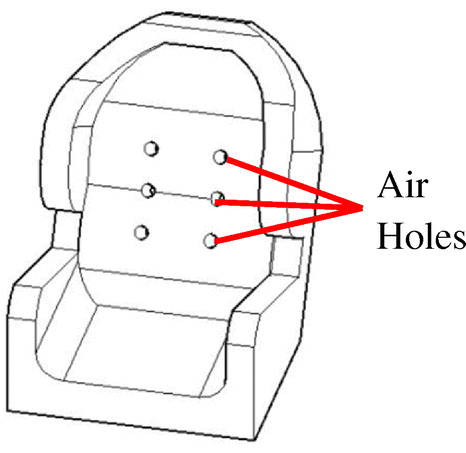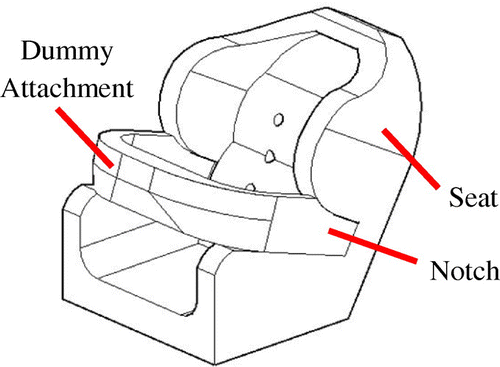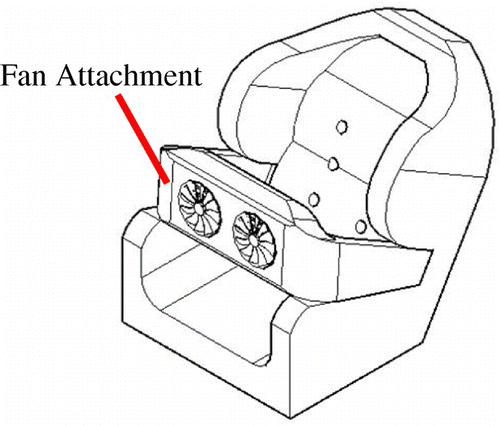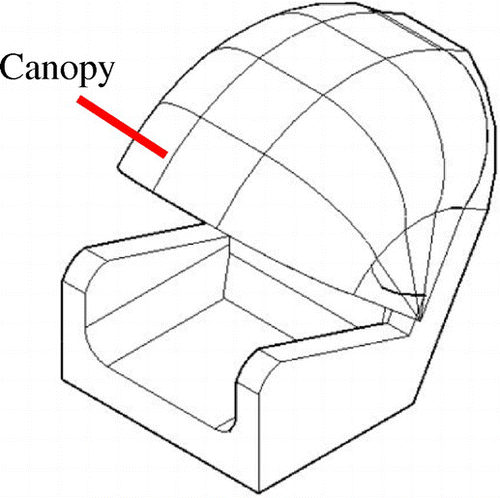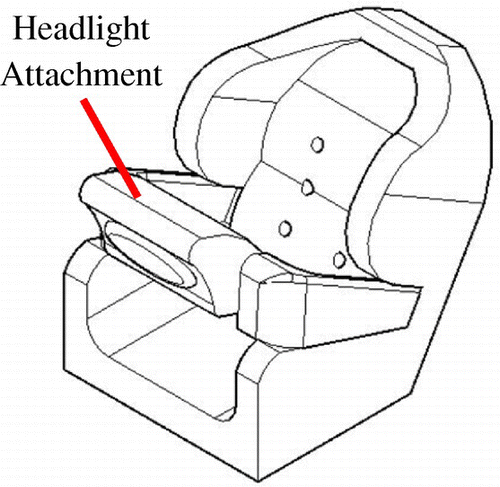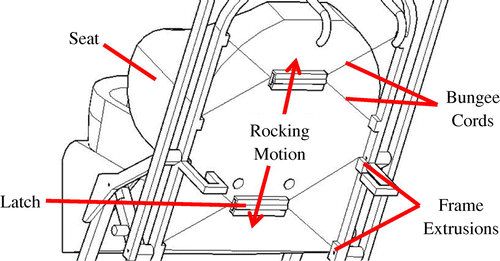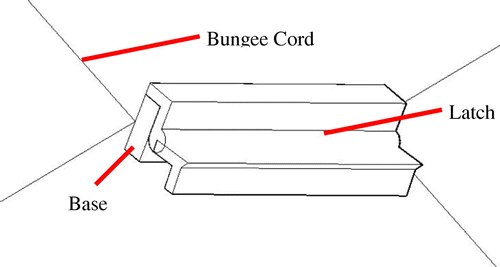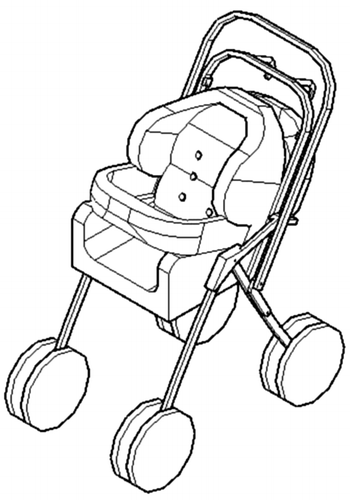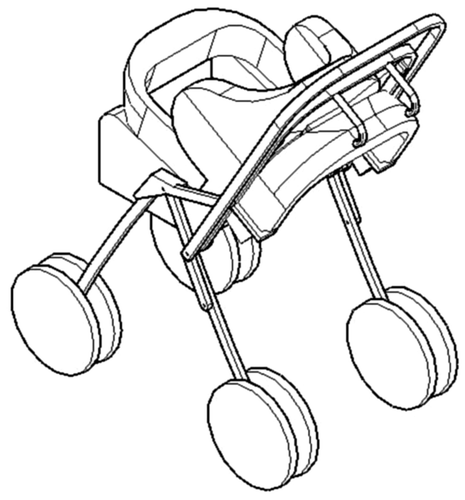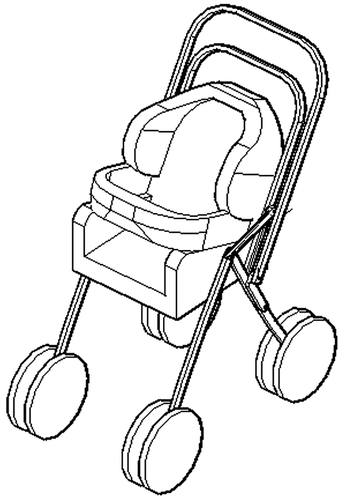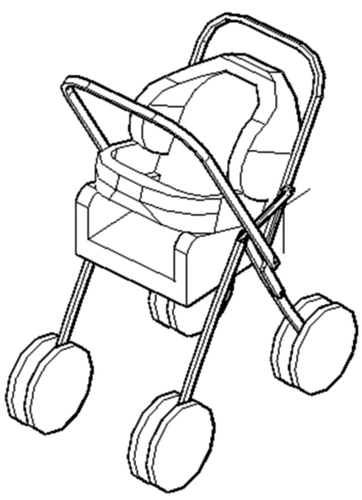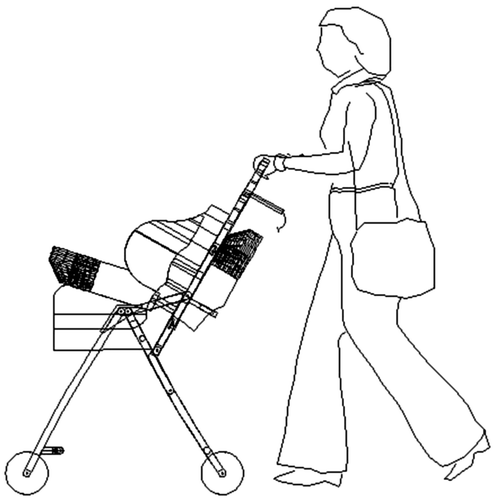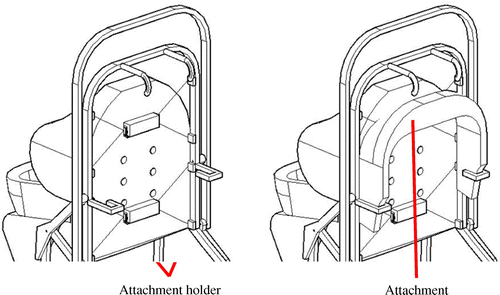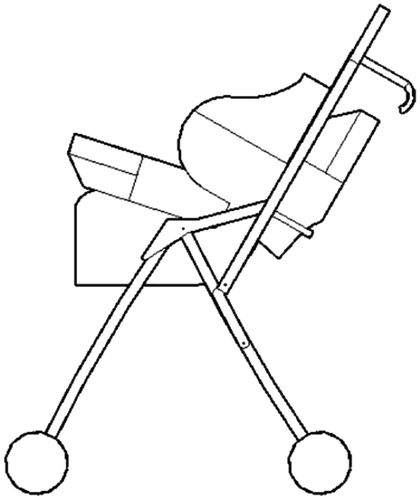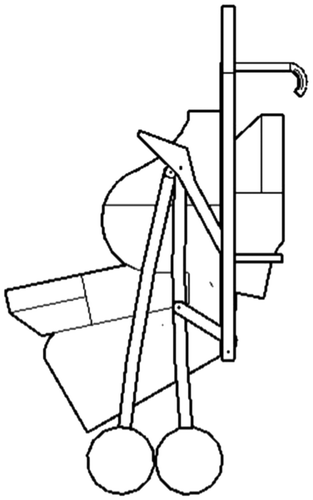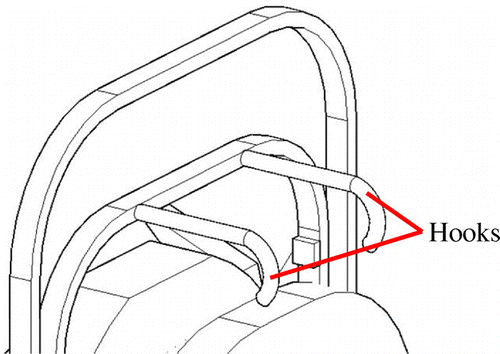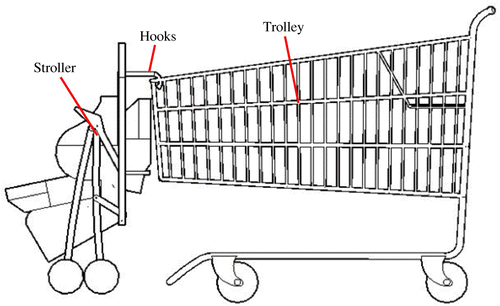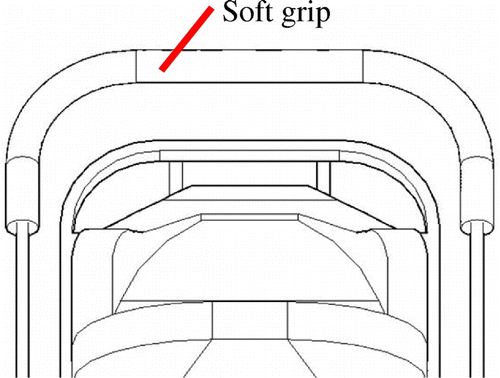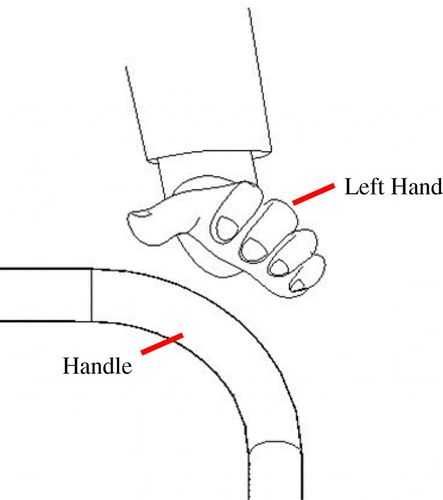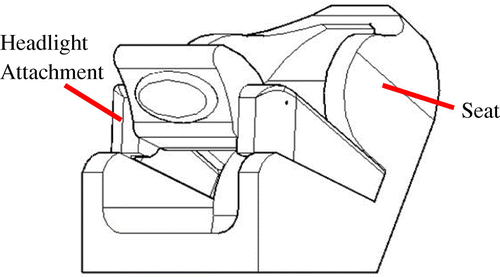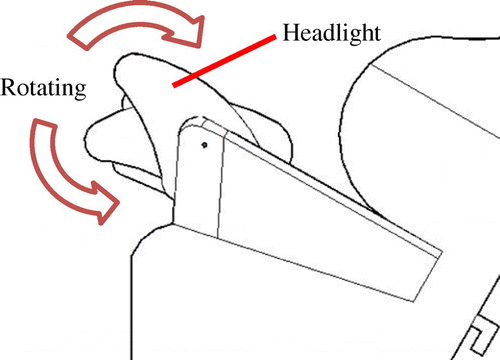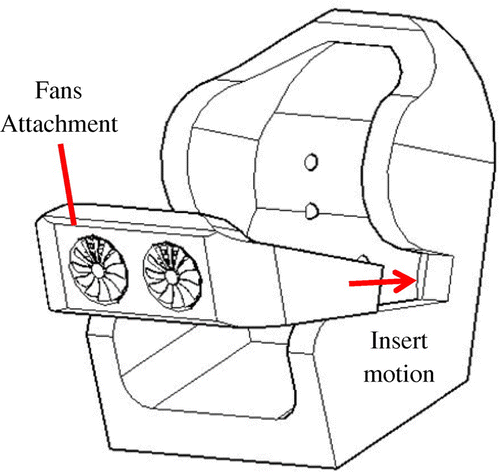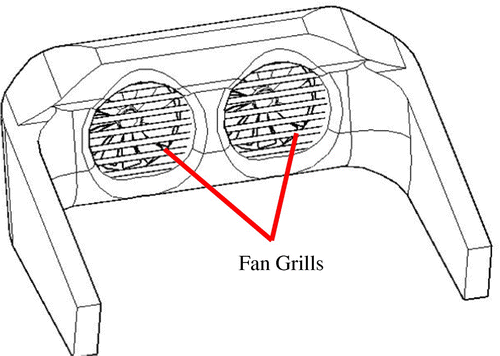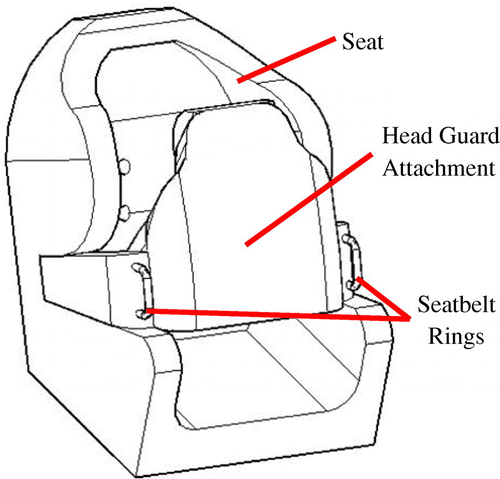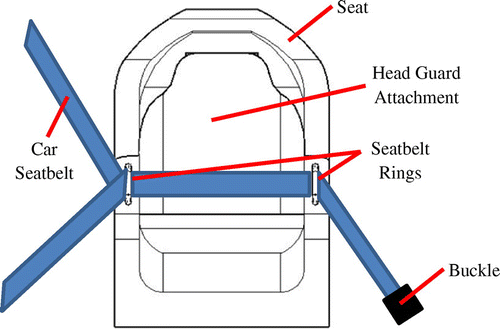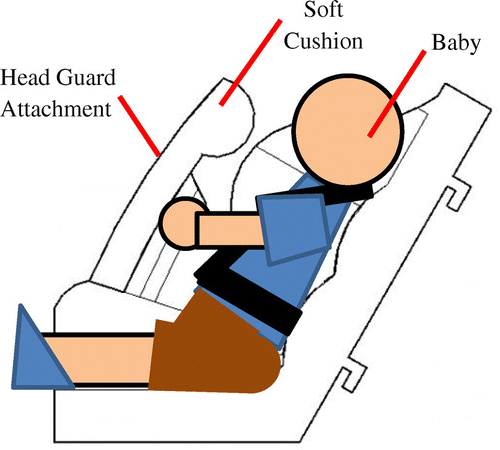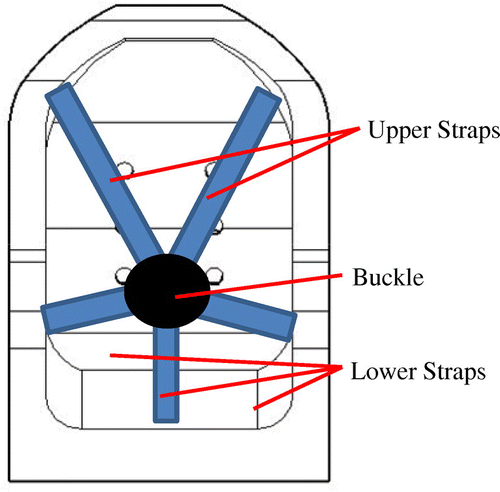Abstract
The current work is an attempt to design and fabricate an ergonomic baby stroller with the latest state of the art features. A review on the design of baby strollers in the previous years was done ranging from the year 1980 to 2014. Based on the review it was found out that the idea of a foldable frame emerged since the early 1980s where people started to prioritize space saving. The use of electronics devices in strollers has not been properly implemented due to the bulkiness of the battery and the clutter mess of wires. Infant’s safety and comfort has always been the number one priority by designing a seat that is contoured to a baby’s spine, ultimately making baby’s growth much safer. In lieu of the current work, a harmonious prototype design was fabricated using Rapid Prototyping system. The idea was to fuse the usage of electronics with the stroller by inventing modular “plug and play” attachment devices that provide customizability to baby strollers which include headlights and cooling fan attachments. Besides that, the latest state of the art designs of the ergonomic baby stroller such as a ventilated back rest, on-board rocking baby chair, bidirectional push handle with ergonomic grip support, frame with integrated hooks for storing different types of “plug and play” attachments and hooks for attaching the foldable stroller to a typical standard shopping cart were implemented.
Public Interest Statement
Baby strollers are increasingly popular among the generations of baby boomers. Despite the popularity, the state of innovations in the design of baby strollers has plateaued in recent years. This article illustrates the evolution of the design of baby strollers from the year 1980 to 2014. Based on the review, it was found out that the idea of a foldable frame emerged since the early 1980s where users started to prioritize space saving. The use of electronics devices in strollers has not been properly implemented due to the bulkiness of the battery and the clutter mess of wires. In lieu of the current work, the idea was to fuse the usage of electronics with the stroller by inventing modular “plug and play” attachment devices that provide customizability to baby strollers that include headlights and cooling fan attachments. The possibilities of various types of attachments will be endless.
1. Introduction
There is significant design knowledge of baby strollers since 1980 to 2014, in which, is reviewed to identify flaws and advantages of each design. There are many methods used to transport babies around and it varies among different cultures and countries. The idea of infant transportation emerges as multitasking and convenience becomes a necessity in parent’s everyday lives. Having an infant transportation made it easier for parents as babies are no longer needed to be carried by the parents or sit on top of their parents’ back. Babies that are lacking the ability to support their head still and upright are usually carried with slings. Cradleboards are popular among Native Americans to keep babies secure and comfortable (Garrett, McElroy, & Staines, Citation2002).
2. History
The early stroller was developed by William Kent in 1733. William Kent designed the stroller to be clam shaped and it was richly decorated and meant to be driven by a small animal such as a goat. Benjamin Potter Crandall saw the potential of this and was the first person in America to sell baby strollers commercially in 1830s. His son, Jesse Armour Crandall further improves the design by adding brake to carriages, designing a frame that is foldable, and a frame that receives devices such as an umbrella (Amato, Citation2004).
Baby strollers that were built in the old days were usually made of wood and wicker with brass joint as seen in Figure . Those strollers are sometimes heavily decorated with carvings making it as a canvas for the work of art. Baby strollers then are usually named after a royal family such as Balmoral. In 1889, William Richardson design the first reversible baby stroller where the pusher can choose to face the baby or to face away from the baby. In order for this to be possible, the seat of the stroller is reversible. Richardson designed each wheel to move separately so the stroller can be easily be maneuvered. In 1920, prams are very popular with the advantage of larger wheels and the implementations of braking system into prams. The prams are deeper so the baby will have difficulty to climb out. The frame is also sturdier, lighter, and safer thanks to the improvement of designs over the years (Amato, Citation2004; Wall-Scheffler, Geiger, & Steudel-Numbers, Citation2007). In 1965, Owen Maclaren designed a light stroller where light material such aluminium is used as the frame. His design was then mass produced and more light strollers are available for people worldwide (Wall-Scheffler et al., Citation2007). In 1970, a more basic baby strollers was preferred that has a detachable seat (Amato, Citation2004; Wall-Scheffler et al., Citation2007).
Figure 1. An early stroller (Leech, Citation1847).
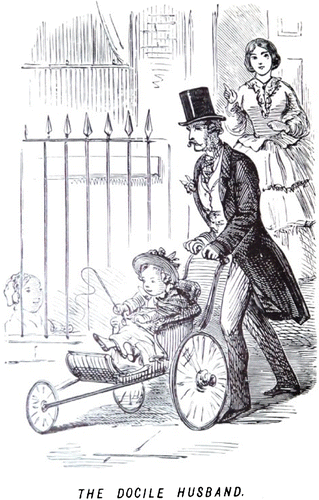
3. Patent reviews
3.1. Year 1980
The design as seen in Figure (a) is invented by Kenzo Kassai. The baby stroller can be collapsed down but increases the size length forward. The stroller has a handle which can be pivoted to change the direction, either forward facing position or a back facing position with respect to the baby sitting in the stroller or carriage (Kassai, Citation1980). Forward facing push type is where the person pushes the carriage is facing the back of the baby in the stroller, and the back facing push type is where the person pushes the carriage views the face of the baby (Kassai, Citation1980).
Figure 2. Baby stroller designs in 1980 (Kassai, Citation1980; Nakao et al., Citation1980).
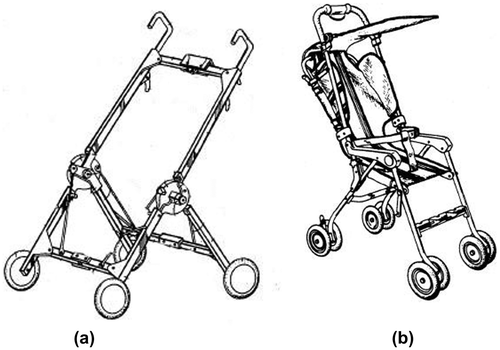
Figure (b) shows a design by Shinroku Nakao, Kouchi Kobayashi, and Kazao Moriya. It is stated as an ornamental design which similar to any other stroller in terms of practicality, but visually appealing (University of Cambridge, Citation2015). The design consists of a fixed chair, with a canopy that folds outwards. The front wheels have no rotating mechanism, which makes maneuvering a little less convenient (Nakao, Kobayashi, & Moriya, Citation1980).
3.2. Year 1981
The invention presented in Figure (a), by Henry Fleischer shows a collapsible frame baby stroller. The collapsible frame uses slider slots and pin joint mechanism. The handle can be rotated to suit the user. The handle also pivots forward, which doubles as a mechanism to engage the folding action. The wheels are not rotatable and use simple axel to keep the wheels in place (Fleischer, Citation1981).
Figure 3. Baby stroller designs in 1981 (Ettridge, Citation1981; Fleischer, Citation1981).
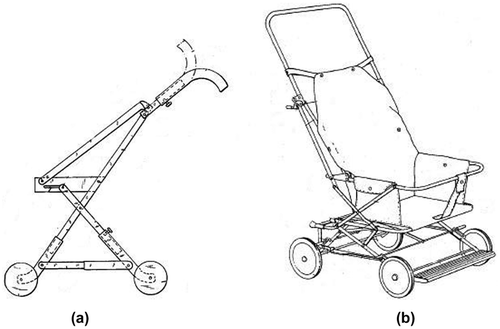
As seen in Figure (b), the stroller design made by John P. Ettridge has a lower seat position where the toddler facing forward. The handle, seat, frame and undercarriage are interconnected by a linkage so that the components fold down towards the wheels as the wheels move towards each other (Ettridge, Citation1981). The design also has a footrest for the toddler. The design has a locking mechanism which keeps the stroller erected. The locking mechanism is conveniently placed at reachable height when standing.
3.3. Year 1982
The stroller in Figure (a) has an adjustable backrest collapsible stroller that has a stroller frame formed in two matched side half-frames each whereof comprises three tubular elements, constituting respectively a rear leg, front leg and a stroller pushing arm. It was designed by Pietro Giordani. The construction of baby strollers of the collapsible or fold down type having an adjustable backrest (Giordani, Citation1982).
Figure 4. Baby stroller designs in 1982 (Giordani, Citation1982; Perego, Citation1982a, Citation1982b).
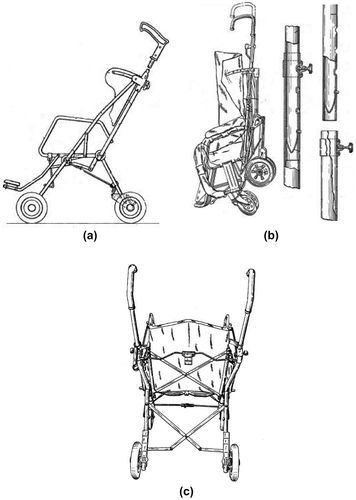
Figure (b) shows a mechanism for adjusting the height of the handles of a baby stroller, consists of two telescopic tubes in which, one sliding in the other and the handle connected to one tube. The spring with two arms with a V-shape fixed on the inside the inner tube. It was designed and drawn by Giuseppe Perego. The handle can be secured in place with notches that has different levels of elevation (Perego, Citation1982a).
Another design also made by Giuseppe Perego which enables the stroller to be folded from side to side. It is made possible by placing linkages that holds the left and the right frames together as shown in Figure (c). The seat has to be made of soft material in order to be folded properly. This design features a rotatable front wheels and lockable back wheels (Perego, Citation1982b).
3.4. Year 1983
The stroller designed by Maurice-Claude Duvignacq has an inclinable support for the seat, connected to a frame which can be folded as shown in Figure (a). The seat is made of sling-like manner, permanently connected to the frame and it is reversible. The hind legs are able to articulate and be fold to form a flat folded position (Duvignacq, Citation1983).
Figure 5. Baby stroller designs in 1983 (de la Fe, Citation1983; Duvignacq, Citation1983; Voytko & Boudreau, Citation1983).
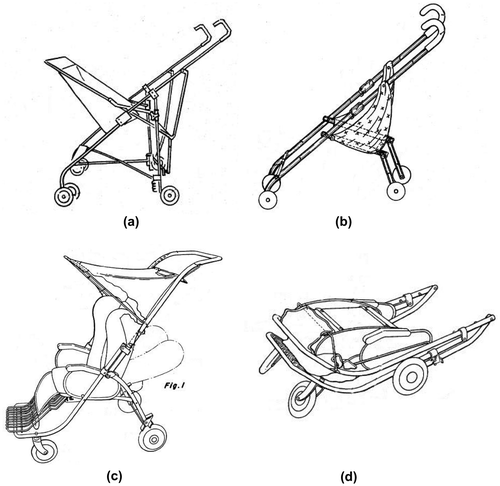
Figure (b) shows a design that can be folded in two directions, side to side and horizontal pivot, made by a Spanish designer Alicia B. de la Fé. It has a pair of side rotating rods which pivots at the center. Having curved handles and fixed front wheels. The back wheels can be folded and it is height adjustable. The seat is made of soft material that is foldable and it is connected on two rods. The stroller can be folded by rotating the side rods and back legs (de la Fe, Citation1983).
A more elegant design by Charles L. Voytko and Robert J. Boudreau which consists of a retractable canopy and an adjustable seat as shown in Figure (c). The canopy structure uses no straps or other attaching mechanism to maintain the canopy in its raised position and it is detachable (Voytko & Boudreau, Citation1983). Front wheels can be rotated with simple horizontal round bearings. The handle can be folded forward and meet the other end of the frame as shown in Figure (d). The folding is completed with one action.
3.5. Year 1984
The invention in Figure (a) has an articulated frame, where it supports the bottom part and the body. The bottom and the framework are connected by a linkage. It was designed by Raymond Guillaume. The frame has a horizontal upper part and has a scissor mechanism that is responsible for the folding action. The linkage that is connecting the two set of wheels acts as a foot rest. The bottom is rigid bottom made of two parts articulated transversely to each other (Guillaume, Citation1984).
Figure 6. Baby stroller designs in 1984 (Guillaume, Citation1984; Hyde & Carmichael, Citation1984; Surot, Citation1984).
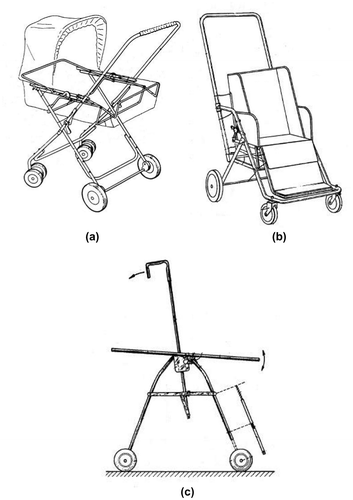
Figure (b) shows a foldable infant stroller which can be opened and folded with one hand, designed by Richard E. Hyde. The folded action can be executed by simply pushing or pulling the handle portion of the stroller against the front wheels. A latch mechanism can be activated to decrease or increase the height of the handle. A hook mechanism can be actuated by the knob on the handle (Hyde & Carmichael, Citation1984).
Figure (c) is a design by Patrick Surot, a reversible foldable baby stroller which folds like an umbrella with both front and back wheels meet at the center. Each branch has a wheel at the end. The seat rotates and changes direction and locks into front facing or back facing positions (Surot, Citation1984).
3.6. Year 1985
The invention designed by Per O. Alldén Växjö in Figure (a) shows a collapsible stroller, specially designed for handicapped children. The carriage has a rectangular, rigid under-frame, formed by two side members with wheeled axles joining the members, which also support the main structure. The main structure is collapsible from an erected position to a folded position downwards. The main structure is self-locking once it is erected, such that it cannot be collapsed by the weight of the baby. The main structure also has armrests the seat (Alldén, Citation1985).
Figure 7. Baby stroller designs in 1985 (Alldén, Citation1985; Miyagi, Citation1985; Nakao et al., Citation1985; Shamie, Citation1985).
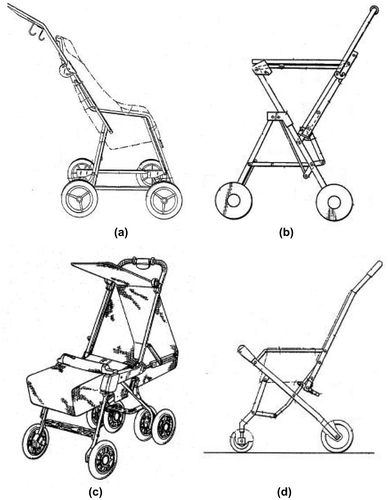
The baby carriage designed by Takeshi Miyagi in Figure (b) essentially has a pair of wheeled front legs which slides along the rear legs. It has a complex folding mechanism which consists of rocker bars. The linkages between the front and rear legs limits the sliding motion of the front legs and preventing it from over extending. The two horizontal bars acts as an arm rest for the baby (Miyagi, Citation1985).
Figure (c) shows a baby stroller design that also doubles as a pram. It was designed by Shinroku Nakao and Yoshiyasu Ishii. The back of the seat can be reclined back to a horizontal position to form a pram. A retractable canopy is placed below the handle that pivots up and down. The handle pivots backwards which forces the front wheels to collapse forward. The back wheels collapses backwards and meet the handle (Nakao, Ishii, & Matsuda, Citation1985). A design by Louis Shamie as shown in Figure (d) is a foldable carriage once it is in an open or folded position. One of the members includes rotatable mounted latch where a pin can be engaged on each members to hold the carriage in its open position. The latch is lockable and cannot be rotated to disengage the pin (Shamie, Citation1985).
3.7. Year 1986
Richard E. Cone designed a collapsible stroller where the seat frame, front frame, rear frame and handle are mounted together and are connected to a pivot as shown in Figure (a). All interconnecting parts are lockable, with a release bar that is located at the handle for one-handed release operation. The structure collapses downwards when folded and the stroller can easily be carried in this manner (Cone, Citation1986).
Figure 8. Baby stroller designs in 1986 (Cone, Citation1986; Harada & Harada, Citation1986; Kassai, Citation1986).
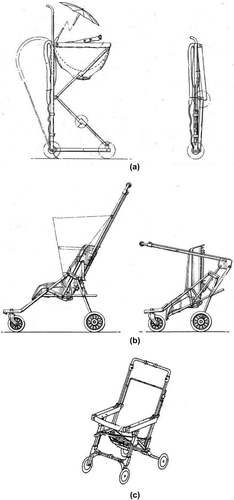
Figure (b) shows a design by Steve N. Harada and Kathleen L. Harada. It is a stroller that has a horizontal wheel base support. The backbone which locks the seat and wheels into place has a slider that allows movement for folding. The height of the handle is adjustable and it is able to receive attachments like a small umbrella. The whole system can be folded into a compact size but requires many folding actions. The vertical backbone design forces the carrier to bend forward as there is not much leg room for walking (Harada & Harada, Citation1986).
Kenzou Kassai designed a baby carriage is equipped with handrails as shown in Figure (c). The sliders can slide along the front legs and the rear legs are hinged to the sliders. When the baby stroller is folded, the handrails rotate while the front legs are folded inwards. The folding action causes the rear legs to fold upwards (Kassai, Citation1986).
3.8. Year 1987
The invention in Figure (a) by Jean Bigo focuses on the improvement of light foldable baby stroller. It has two foldable diagonally supported side bars supporting a flexible seat, which is connected near the handle and at the lower end near the front wheels. It has two vertical columns supporting an X-frame to improve rigidity. The folding mechanism is a scissor type mechanism which folds from side to side. The wheels are supported with extended legs and curved inwards (Bigo, Citation1987).
Figure 9. Baby stroller designs in 1987 (Bigo, Citation1987; Kassai, Citation1987; Mar, Citation1987).
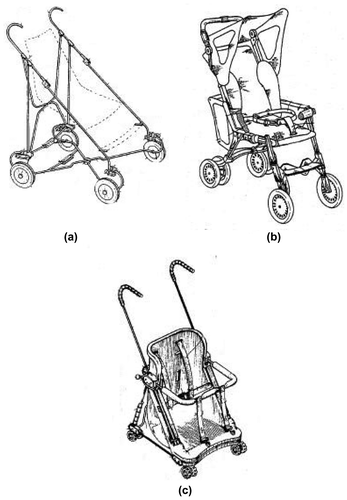
Kenzou Kassai designed a baby stroller that has a seatbelt to secure the baby as seen on Figure (b). The belt is detachable at ends located at the sides. When the belt is fastened, the belt secures the baby in place. The belt is connected with flexible members onto the backrest and the frame that supports the seat (Kassai, Citation1987).
The design in Figure (c) by Shih-Lin Mar is a multi-purpose foldable stroller which has retractable handle and foldable back frame that converts into a baby carrier. Baby carrier is carried at the back of the carrier, similar to carrying a backpack. The seat is detachable and can be converted into a car seat. The handle is retractable and also height adjustable, depending on the pusher’s needs. The arc shape at the front wheels is designed to prevent discomfort while carrying (Mar, Citation1987).
3.9. Year 1988
The invention seen on Figure (a) by Gianluca Perego is a foldable baby stroller with circular frame. The sides fold and the front and back wheels meet each. The handle is retractable from the main frame. The seat is supported onto the main frame and has reclining backrest. The back rest is also connected with a rotating member to the rear legs so that the backrest is also folded when the stroller is in folded position (Perego, Citation1988).
Figure 10. Baby stroller designs in 1988 (Perego, Citation1988; Shamie, Citation1988; Tucker & Weiswurm, Citation1988).
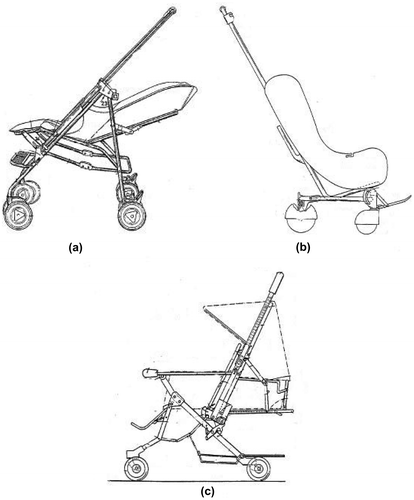
A design by J. Camille Tucker and Klaus D.Weiswurm as shown in Figure (b) is a combination of a car seat and stroller having a set of wheels which can be lowered and turn it into a stroller, or raised position to turn it into a car seat. The handle is height adjustable for the use in stroller mode. Wheels are lockable with a clip when it is used as a stroller. When the wheels are in raised position, it allows the stroller to be placed on the seat of an automobile, an airplane seat, or other surface. Slots in the armrests are designed to fit the seatbelt of an airplane or a car. The footrest is retractable and it is linked to the front wheels (Tucker & Weiswurm, Citation1988).
A foldable Tandem Stroller designed by Louis Shamie as shown in Figure (c) includes a backrest which can be folded down to form a bed. The footrest can be lowered and becomes a second bed. To form a stroller, the footrest is placed back into position and the backrest of the first bed is inclined back to upright position. The stroller turn into beds for two children and it is called a Tandem Stroller (Shamie, Citation1988).
3.10. Year 1989
The invention shown in Figure (a) and Figure (b) is a baby stroller with a reclining seat. It was designed by Albert W. Gebbard. The seat is a shape of a basket, specially designed to become a seat when it is inclined, and turn into a bed when reclined. The wheels are connected with a rectangular frame at the bottom part of the stroller (Gebhard, Citation1989).
Figure 11. Baby stroller designs in 1989 (Gebhard, Citation1989; LaFreniere, Citation1989; Nakao et al., Citation1989; Yanus, Citation1989).
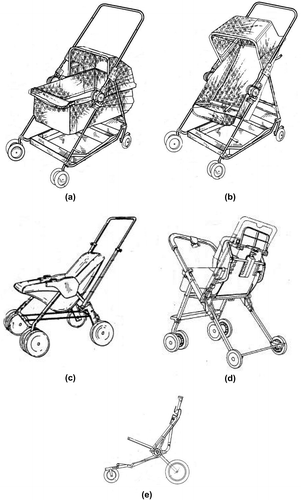
In Figure (c) is a convertible baby stroller that can be used as a stroller and a car seat, designed by Terry R. LaFreniere. The rear wheels pivots and controls the angle of the seat position. The handle is retractable and provides height adjusting and can be completely hidden when in car seat position. The front wheels can be rotated and it is mounted directly to the frame. The linkages that link the front and the rear legs provides the support for a basket (LaFreniere, Citation1989).
The design by Shinroku Nakao, Yoshiyuki Suzuki; Hitoshi Kato in Figure (d) is a foldable baby stroller having a handle that swivels. The swiveling handle allows the pusher to face the baby, or to face the back of the baby when pushing. Within a lower portion on each side of the handle bar is located a slider casing containing two sliders. The sides of the handle each have sliders and pusher can adjust the height of the handle. The height adjusting can be done by pressing the push button located at the middle of the handle and it is operated by cables (Nakao, Suzuki, & Kato, Citation1989).
The design in Figure (e) is a bi-directionally convertible baby stroller by Theodor M. Yanus. The conversion is done by a single push button action the discs in the middle of the frames connect all the members including the handle and the wheels. It acts as a pivot and all the folding action happens there. The stroller can be folded if the pusher intends to turn it into a car seat (Yanus, Citation1989).
3.11. Year 1990
The invention in Figure (a) refers to some improvements in the foldable frames for baby strollers. The handle can be slid out, and the whole stroller is folded with the handle swivels forward. It was designed by Ramon J. Cabagnero. These improvements, presented a baby stroller with a simple structure and very compact folding position. This is achieved by the triangle frame design of the lower part of the stroller (Cabagnero, Citation1990).
Figure 12. Baby stroller designs in1990 (Cabagnero, Citation1990; Chen, Citation1990; Sadler, Citation1990; Takahashi & Katou, Citation1990).
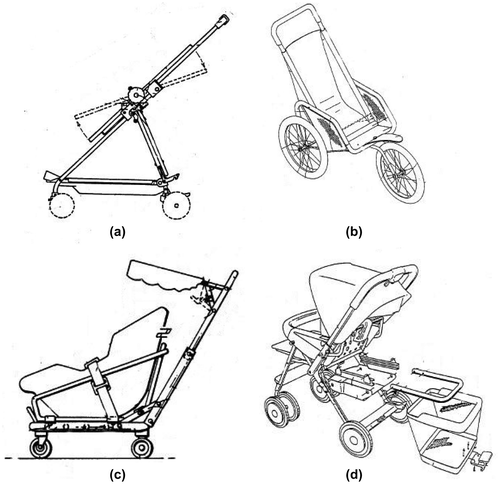
Figure (b) shows a design by Franys Chen with a frame body is supported by large rear wheels. The seat is support by a U-shaped frame and the U-shaped frame is connected to the rod in between the rear wheels. The seat can be reclined and pivots at the lower part of the stroller. The front wheel is placed in between the fork that extends forward. The front can be turned to the back if the stroller is not in use and it is to be stored (Chen, Citation1990).
Edward L. Sadler Jr. and Edward L. Sadler Sr. designed an infant conversion stroller as seen on Figure (c) The canopy is connected to the handle it is retractable. The handle swivels and can be folded forward if the stroller is not in use. The seat is a basket shaped and it is removable. In the folded position, the seat together with the stroller is used as a car seat (Sadler, Citation1990).
In Figure (d) is a baby stroller designed by Takehiko Takahashi and Hitoshi Katou that has a compartment for shopping purposes. The basket for shopping can slide outwards and it is removable. The smaller basket can also accept another larger basket that extends outwards, away from the stroller (Takahashi & Katou, Citation1990).
3.12. Year 1991
Figure (a) shows a stroller design by Chia-Ho Wang which has a wheeled carriage frame, a pair of hollow upward back frame supports mounted to the wheel frame. The handle swivels to change the direction of the pushing action and it is also foldable to change the height of the handle. The top piece of the handle is also able to slide out to increase the height of the handle. The back support frame is able to move along the arm rest (Wang, Citation1991).
Figure 13. Baby stroller designs in 1991 (Bigo, Citation1991; Lockett et al., Citation1991; Wang, Citation1991).
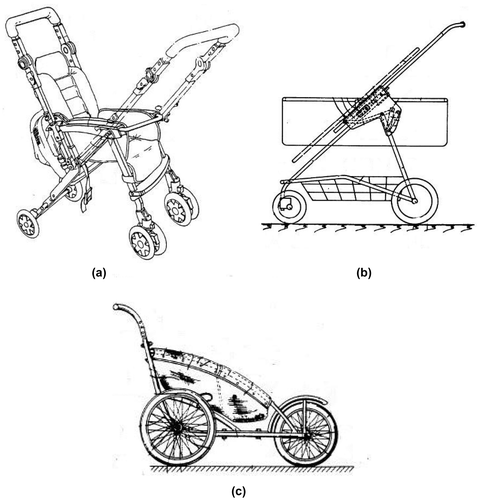
The design by Jean Bigo in Figure (b) is a foldable baby pram which consists of main structure that holds an articulating body. The folding mechanism uses several linkages in which the rear wheels folds upward. The articulating body pivots in between the front wheels and the handle. The structure that holds the front and back wheels are rigid and support a basket (Bigo, Citation1991).
Dennis Lockett, James T. Hruby and John G. Roth designed a convertible baby stroller that doubles into a trailer as seen in Figure (c). The design has an extra flexible seat to hold another passenger. To switch it into a trailer mode, the front wheel is removed and can be attached to a vehicle such as a bicycle. Another end of the tow bar is attached to the rear of a towing vehicle, such as a bicycle frame. In the trailer mode, the weight is concentrated at the rear wheel and exerts very little load at the vehicle end. Since the center of gravity is low, the stroller is very stable in either mode and has no issue in doing sharp turns when in trailer mode (Lockett, Hruby, & Roth, Citation1991).
3.13. Year 1992
A collapsible stroller frame designed by Janet L. March adapted to carry variously sized and shaped infant type seats as shown in Figure (a). The main frame supports the handle at the upper end and front wheels at the lower end. The supports of the rear wheels are connected to the support of the seat and it is articulating at the middle of the main support frame. The stroller can be folded flat with the rear wheels meet the front wheels and the support for the seat leans back towards the main support frame. The seat is removable and it is attached with slings and straps (March, Citation1992).
Figure 14. Baby stroller designs in 1992 (Chen, Citation1992; Cone, Citation1992; March, Citation1992; Owens, Citation1992).

The design in Figure (b) by Richard E. Cone is a convertible baby stroller which is also a car seat. It is simple yet clever design where the rear wheels folds up and the front wheels rotate inwards. The handle is retractable with the shape matches the top part of the seat so that it is flushed when it is retracted. The folded stroller can be placed in any vehicle that has seat surface (Cone, Citation1992).
Figure (c) shows a design by Valerie Owens which is a convertible baby stroller that can be used as a baby carrying basket, a baby stroller, and a car seat. The seat is detachable from the stroller frame and can be used as a car seat. The car seat is then fastened with a regular seatbelt. The handle unlocks the seat be swiveling it upright and so the seat can be removed. With the same handle, the seat turns into a baby carrying basket (Owens, Citation1992). Franys Chen designed a stroller that has a main frame which includes a front fork end that is holding the front wheel. It also has two rear wheels as seen on Figure (d). The U-shape member is detachable from the lower part of the main frame. The stroller can be folded when the U-shaped tube member is detached from the main frame. The rear wheels can also be detached from the main frame for easier storage (Chen, Citation1992).
3.14. Year 1993
In Figure (a), Hitoshi Kato and Yuichi Arai designed a stroller with a detachable seat, having a reclining backrest. When the seat is not attached to the stroller body, the seat may be used as a carrier with carrying straps. In stroller mode, the baby’s legs are protected by a cover and it is also detachable (Kato & Arai, Citation1993).
Figure 15. Baby stroller designs in 1993 (Chaw & Hwang, Citation1993; Garforth-Bles, Citation1993; Kato & Arai, Citation1993).

The design in Figure (b) by Timothy Garforth-Bles is a multi-purpose sports baby stroller which can be converted into a stroller that is pushed by a person jogging or running and also wheeled trailer for towing behind a vehicle like bicycle. All the wheels can be removed and the stroller is used as a sled for riding in the snow (Garforth-Bles, Citation1993).
Figure (c) is a design by Natural Chaw and Hemg-Der Hwang which is a multi-purposed stroller with a canopy. The seat is attached to a rigid frame and the rear wheels are also attached to the same frame. The seat has a footrest that is attached to the rigid bottom frame. A fork structure extends forward that is holding the front wheel. An inverted U-shape serves as a handle and it is height adjustable (Chaw & Hwang, Citation1993).
3.15. Year 1994
Timothy Garforth-Bles designed a multi-purpose sports baby stroller which can be pushed by a jogger as shown in Figure (a). The rigid frame consists of two rear wheels located at the back and a seat in the middle. The front wheel can be removed so the stroller can be towed by a vehicle such as a bicycle. When all the wheels are removed, the baby stroller is converted into a sled and to be pulled by dogs or skier in the snow (Garforth-Bles, Citation1994).
Figure 16. Baby stroller designs in 1994 (Chen, Citation1994; Garforth-Bles, Citation1994; Smith, Citation1994).
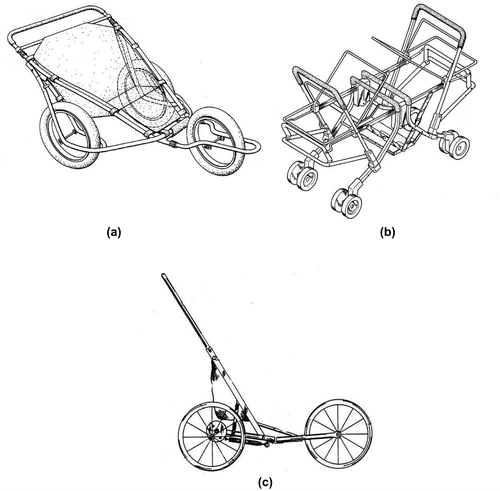
The design shown in Figure (b) by Shun M. Chen is a double seated stroller where the two infants face each other. It is a symmetrical design if viewed from the side with a collapsible handles and wheels. The structure that holds the two basket shaped seats is rigid and the frame support footrests in the middle of the frame. The stroller can be folded by folding the two handles outward and the wheels will follow suit (Chen, Citation1994).
Figure (c) is a design by Clark D. Smith which is a collapsible baby stroller that has two rear wheels and one front wheel. The base of the frame is foldable and the folding mechanism is locked by a linkage in the middle of the frame. The seat is a flexible and it is located in between the back wheels. The front wheel folds upwards to meet the handle for storage purposes (Smith, Citation1994).
3.16. Year 1995
Frank Wang designed a foldable baby stroller that includes a foldable and flexible seat as seen on Figure (a). The handle and the front wheels swivel in order to be folded. The backrest of the seat can be reclined and footrest is also available. The front wheels swivels inward to meet the rear wheels when folded. The handle can also be folded to meet the rear wheels. Mounting points for canopy is available, which can be retracted if not needed (Wang, Citation1995).
Figure 17. Baby stroller designs in 1995 (Andrisin, Citation1995; Bigo, Citation1995; Wang, Citation1995).
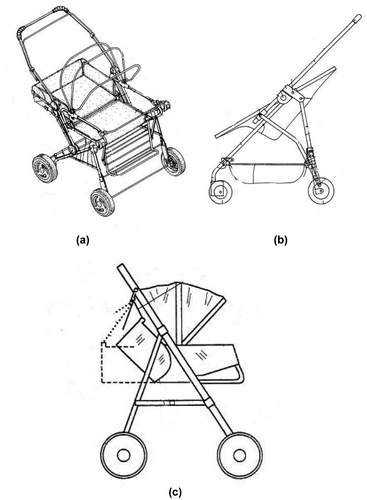
Jean Bigo and Laurent Ageneau designed a compact folding baby stroller as in Figure (b) which consists of front legs and rear legs that each carries one wheel. The handle can slide downwards and the members of the rear wheels folds inward and meet the front wheels. The frame that supports the seat rotates about the middle of the frame and can be locked on the desired angle. The seat frame is able to receive a regular stroller seat or a baby basket. At the bottom of the frame, a special compartment is design to receive a multi-purpose basket (Bigo, Citation1995).
Figure (c) is a design by John J. Andrisin which is a baby stroller that has an adjustable reclining mechanism for the seat. It has a retractable canopy that is attached to the handle of the stroller. The rear wheels swivels inwards to meet the main frame that is connect to the handle. The reclining backrest is supported by a linkage that links to the handle (Andrisin, Citation1995).
3.17. Year 1996
The design shown in Figure (a) is a baby stroller with and adjustable backrest. The backrest is adjusted with a belt mechanism. It was designed by Tadashi Kitayama and Ichiro Onishi. The belt assembly includes two belts where the first belt is attached to the frame, and the second belt is attached to the backrest. The backrest can be adjusted by fastening the second belt with a lockable buckle. It is also foldable where the rear legs folds inwards and meet the front legs. The folding action can be engaged by a simple push button at the handle (Kitayama, Citation1996).
Figure 18. Baby stroller designs in 1996 (Aitken, Citation1996; Huang, Citation1996; Kitayama, Citation1996).
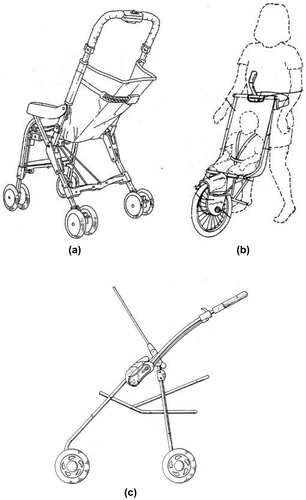
Warwick Aitken designed a single wheel running baby stroller for carrying a baby as in Figure (b) which has a large front wheel with a U-shaped frame and footrest for the baby. It has no back wheels and the back of the stroller is attached to the waist of the pusher. The seat is flexible and it is attached to the U-shaped frame (Aitken, Citation1996).
The design in Figure (c) by Li-Chu C. Huang is a baby stroller that can be folded into a compact size. The members that support the front wheels are attached to the handle and the member of rear wheels is able to fold inwards. The structure that supports the seat is attached to the front wheel members and the handle (Huang, Citation1996).
3.18. Year 1997
A three-wheeled collapsible baby stroller as seen on Figure (a), which was designed by Anthony E, Eichhorn, can be used on an off road terrain. The stroller has a folding frame and can be activated with the automatic side latches so that it can be folded into a compact form for transportation and storage. The stroller also had a seat where the backrest is adjustable. The seat remains in position when it is folded and the front wheel folds upwards. The brakes on the rear wheels are automatically activated when the stroller is folded (Eichhorn, Citation1997).
Figure 19. Baby stroller designs in 1997 (Eichhorn, Citation1997; Graziano & Graziano, Citation1997; Kolbus, Citation1997).
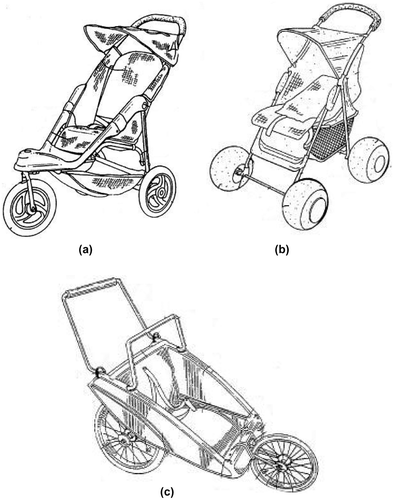
Edward Graziano and Denise Graziano designed a child carriage assembly as seen in Figure (b) It has a foldable rear wheels which pivots at the structure in between the handle and the front wheels. The wheels are large and hollow with axles connected to the frame. The stroller also has a retractable canopy which extends forward. The seat is a basket type where the baby sits at almost horizontal position (Graziano & Graziano, Citation1997).
In Figure (c) is a design by Brian D. Kolbus and Richard H. Jacobs where the stroller has two rear wheels which are connected to the frame that holds the seat. The front wheel is detachable to be towed. When the front wheel is removed, the stroller is configured into a trailer, where it is towed by a vehicle such as a bicycle (Kolbus, Citation1997).
3.19. Year 1998
A baby stroller which was designed by Nathanael Saint and Robert Tor Pike has a break-away basket situated underneath the stroller seat or backrest as seen on Figure (a). From the sides, the frame has a parallelogram shape that folds into a compact form. The basket for the baby swivels about the middle of the frame. The second basket is located at the bottom of the frame for the purpose of storing things. When the baby basket inclines upwards, it becomes a seat. The rear wheels also folds inwards following the motion of the basket. Once the basket turns into a seat, the baby will be able to use the footrest located near the front wheels (Saint & Pike, Citation1998).
Figure 20. Baby stroller designs in 1998 (Huang, Citation1998; Saint & Pike, Citation1998; Wang, Citation1998).
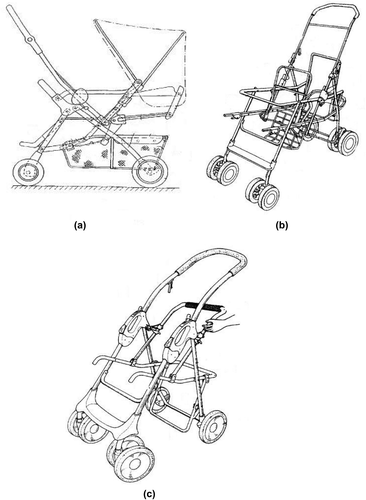
Morgan Wang designed a foldable two-seater stroller as seen on Figure (b) which includes a U-shaped seat frame, front and rear backrest members mounted to the seat frame. The double seat frame is collapsible where the frame folds from a parallelogram into a flat frame. Each set of wheels has two wheels connected side by side of each other. The handle slides up and down and it is adjustable. The structure that holds the two seats is the U-shaped frame that expands from the front of the frame to the back of the frame (Wang, Citation1998).
A baby stroller designed by Li-Chu Chen Huang in Figure (c). has a folding mechanism that can be activated by pulling the second handle that is located below the main handle. The second handle also supports the seat where the seat is detachable. The front wheels are capable of rotating and improves mobility (Huang, Citation1998).
3.20. Year 1999
In Figure (a), Michael A. Andrus designed a baby stroller that includes a frame inclined downward and forward. The rear wheels folds towards the handle and it is controlled by a set of linkages. The main frame is a simple oval shape design where the overall weight of the stroller is reduced but without compromising rigidity (Andrus, Citation1999).
Figure 21. Baby stroller designs in 1999 (Andrus, Citation1999; Chen et al., Citation1999; Davidson, Citation1999).
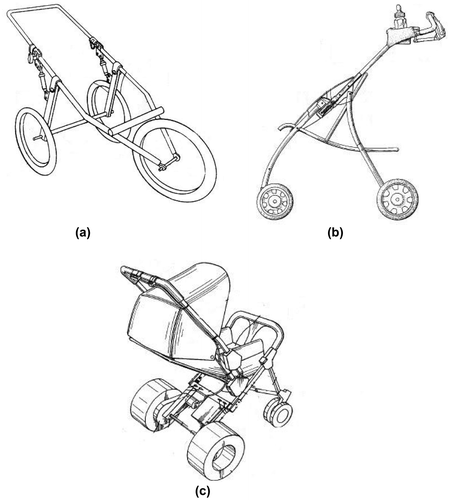
Er-Jui Chen, Hung-Chung Hou, and Ying-Yuan Huang designed a stroller as seen on Figure (b) where the front wheels and rear wheels meets together when folded. The structures are curved and the handle extends upright. The legs are curved and bulge forward (Chen, Hou, & Huang, Citation1999).
Figure (c) shows a motorized baby stroller designed by Wayne Davidson. It includes a main frame member adapted to support a seat for the baby. Underneath is an electric powered motor located in between the rear wheels. The mid-section of the main frame extends upwards, connecting the handle. Near the upper end of the main frame, attached is the swiveling support for the front wheels. The front wheels rotate in place. The motor provides power to the axle of the rear wheels through a gear reduction unit. The motor can be disabled and disengaged, and the baby stroller can be manually pushed (Davidson, Citation1999).
Joan Rura designed a baby carriage with cooling mechanisms that is mounted on top of the baby basket as seen on Figure (a) The carriage includes four wheels with a collapsible frame. The cooling mechanism is mounted on the canopy and the canopy is retractable. The cooling mechanism is battery operated (Rura, Citation2000).
Figure 22. Baby stroller designs in 2000 (Hartenstine, Citation2000; Lan, Citation2000; Rura, Citation2000).
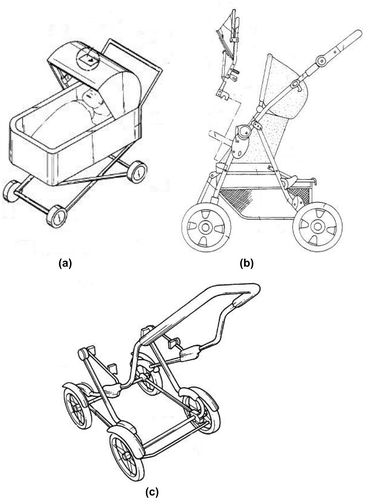
A stroller designed by Red Lan as seen on Figure (b) includes a main frame, an adjustable seat unit and a mounting unit. The mounting unit serves the purpose to mount a footrest for the baby. The stroller is collapsible with the handle and the rear wheels swivel inwards. A utility basket occupies the bottom part of the stroller in between the two sets of large wheels (Lan, Citation2000).
Curtis M. Hartenstine designed a stroller that has a frame, a plurality of wheels, and brake assembly as seen on Figure (c). The brake assembly includes a mounting member fixed on four corners of the bottom frame. The brake pads surround the upper part of the wheels where it is ready to grip the wheels when activated. The frame is collapsible with a simple downwards motion of the handle (Hartenstine, Citation2000).
3.21. Year 2001
Douglas Anderson designed a jogging exercise stroller having a pair of pivotally connected arms as seen on Figure (a). The pusher swings the arms of the handle while running. The frame consists of three large wheels and a low center of gravity seat mount. The seat includes a footrest near the front wheel (Anderson, Citation2001).
Figure 23. Baby stroller designs in 2001 (Anderson, Citation2001; Glover et al., Citation2001; Worth, Citation2001).
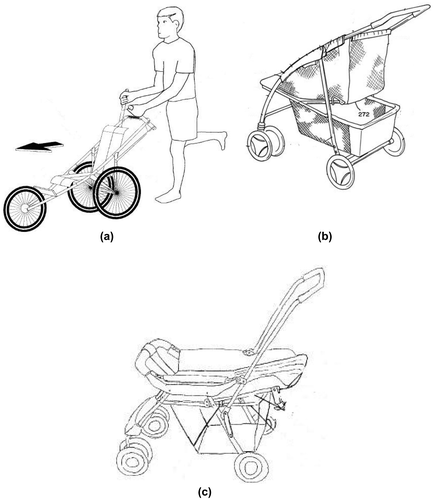
In Figure (b), Richard E. Cone, Richard Glover, and Dennis M. Turner designed a stroller that includes a frame, a stroller seat mounted to the frame, and a pair of removable seat adapters. With the adapters, the seat can easily be removed from the frame (Glover, Cone, & Turner, Citation2001).
Ronald K. Worth designed a stroller as seen on Figure (c) that accepts and supports various types of child’s car seats. The stroller can easily be folded by releasing a latching mechanism and the stroller stays upright when folded. The seat is held by a latch and the mounting structure of the frame supports various types of car seat. An extra basket can be added at the lower part of the frame for utility purposes (Worth, Citation2001).
3.22. Year 2002
In Figure (a), Ben M. Hsia designed a foldable baby stroller where the seat is detachable from the frame. Once the seat is detached, the structure that supports the seat is also foldable making the stroller more compact once folded. The main structure is a U-shaped that curves at the handle and ends at the front wheels. The stroller folds where the rear wheels swivel inwards and the seat structure swivels upwards. It has rotating wheels which improves mobility when turning (Hsia, Citation2002).
Figure 24. Baby stroller designs in 2002 (Hsia, Citation2002; Suh, Citation2002; Suzuki, Citation2002).

In Figure (b), Yoshiyuki Suzuki designed a baby stroller that collapse downwards when folded. The opened position is held by a locking linkage that links the rear wheels to the main frame. A fixed canopy is mounted on the handle. A fixed rigid structure that stretches out of the main frame supports the seat and the seat is detachable (Suzuki, Citation2002).
In Figure (c), Simon Suh designed a baby stroller with an adjustable holder for utilities. The holder with a V-shaped structure is mounted on the handle. The arm that holds the utility is bendable but stays rigid if no force is applied. The holder can hold various things including baby bottle (Suh, Citation2002).
3.23. Year 2003
In Figure (a), Timothy J. C. O’Shea designed a collapsible three-wheeled baby stroller. The stroller is able to move either in folded or opened position. The frame consists of a triangular structure at the bottom which supports the three wheels. The handle is the collapsible structure with two separate handles protruding upwards. The handle bars also support the flexible seat. The stroller folds downwards where the handle bars meet the rear wheels. The stroller stays in opened position by the locking linkages in between the handle bars and the bottom frame (O’Shen & Ayre, Citation2003).
Figure 25. Baby stroller designs in 2003 (Barenbrug, Citation2003; Hsia, Citation2003; O’Shen & Ayre, Citation2003).
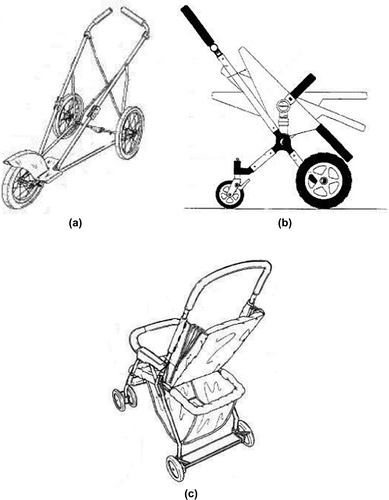
In Figure (b), Machiel Gerardus Theodorus Marie Barenbrug designed a buggy that includes a frame with front and rear wheels. It has a rotating seat support and the position can be locked with the latch at the sides. The stroller folds and stands upright once it is folded. The buggy has large wheels which is suitable for rough and rugged terrain (Barenbrug, Citation2003).
In Figure (c), Ben Ming Hsin designed a baby stroller with an adjustable backrest. The backrest can be extended with extra material that was once folded neatly when it is in upright position. The folded extra material is hidden with zippers, thus locking the seat in upright position. The front wheels are able to rotate and a utility basket is available (Hsia, Citation2003).
3.24. Year 2004
In Figure (a), Wayne H. Hanson, Wade M. Wolf, and William B. Phelps designed a baby stroller and a stroller base suitable for use with handicapped children. The seat is detachable and the base of the seat is height adjustable. Tilt position can also be adjusted. The height adjust is important for the children to reach at a certain level of height such as dinner table. The stroller is also designed so that it is suitable for both indoor and outdoor use (Hanson, Citation2004).
Figure 26. Baby stroller designs in 2004 (Hanson, Citation2004; Lan, Citation2004; Lin, Citation2004).
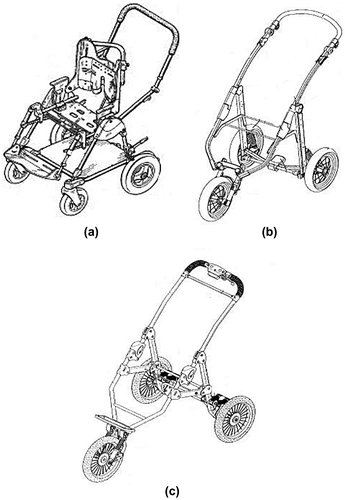
In Figure (b), Red Lan designed a foldable baby stroller that includes a positioning member that is fixed on the inclined lower rod at the front wheel unit. A guide member is fixed on the upper rod of the handle unit. The handle is height adjustable by extending the sliding members in the middle of the frame. The rear wheels have shock absorption mechanisms which are attached to the axle of the wheels. The stroller folds and stands upright with the rear wheels swivel inwards and pivots at the middle of the frame (Lan, Citation2004).
In Figure (c), Wan–Hsing Lin designed a foldable three-wheel baby carriage that includes a mount for a device at the handle. The front wheel is installed with two shock absorber units and the rear wheels each have one shock absorber unit. The rear wheels also have brakes installed and can be activated by a push button at the handle. The braking system is utilizing wires that are hidden within the frame thus improving the aesthetics of the stroller (Lin, Citation2004).
3.25. Year 2005
In Figure (a), Jyan-Tsai Guo designed a baby stroller that folds from side to side. The handles can be rotated depending on the pusher’s needs. All the wheels are able to rotate in place which improves the mobility of the stroller. A scissor folding mechanism is attached to back structure behind the seat support. Another scissor folding mechanism is also attached to the bottom of the stroller, connecting the left and right wheels (Guo, Citation2005).
Figure 27. Baby stroller designs in 2005 (Bretschger & Myers, Citation2005; Guo, Citation2005; Yoshie et al., Citation2005).
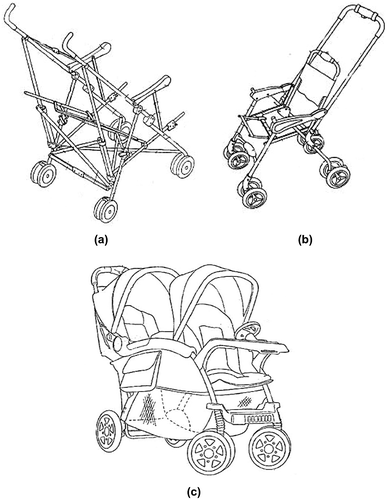
In Figure (b), Toshiro Yoshie, Yutaka Ukitsu, and Tokihiko Ikuno designed a baby stroller with an adjustable backrest. It is also foldable with the front wheels swivels backwards and the handle swings forward. The handle is height adjustable and also holds the push button that activates the folding mechanism. All the wheels are able to rotate in place and each set of wheels have two wheels. The footrest for the baby is also adjustable depending on the length of the baby’s legs, or it can be folded completely if not needed (Yoshie, Ukitsu, & Ikuno, Citation2005).
In Figure (c), Edward B. Bretschger and Peter J. Meyers designed a baby stroller that is capable of receiving two children. The main frame arcs to the front where the front wheels are located. The front wheels are able to rotate in place. The seats are place within the main frame and the back seat is facing the front seat. Both seats have own canopy and both are retractable. Both seats also have own footrest. The back seat is placed a little higher than the front seat (Bretschger & Myers, Citation2005).
3.26. Year 2006
In Figure (a), Gary Lee Besaw designed a combined baby car seat and stroller that includes a base member that is mounted on the frame and to the seat of an automobile. The seat is detachable and lockable with the base member. The seat member includes a retractable canopy. The seat includes a carry handle which also function as a locking mechanism of the seat. The seat can be locked by swinging the carry handle forward. The seat has and adjustable backrest and also an adjustable footrest (Besaw, Citation2006).
Figure 28. Baby stroller designs in 2006 (Besaw, Citation2006; Knight, Citation2006; Sedlack, Citation2006).
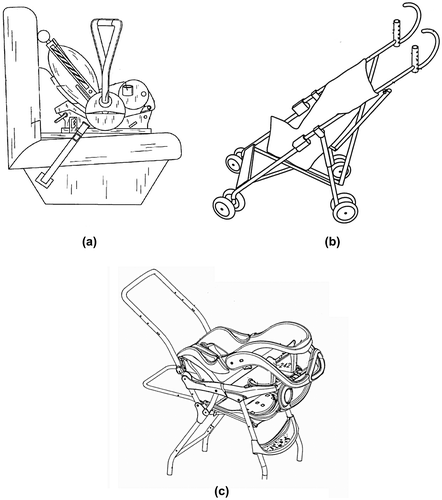
Figure (b) shows a design by Deven Faye Knight where the handles are height adjustable at a vertical direction. This design allows the pusher’s distance to be the same when the handles are adjusted. The baby stroller is collapsible from side to side and the seat is made of a flexible material (Knight, Citation2006).
In Figure (c), Mark Sedlack designed an improved baby car seat that can be attached to and detached from a car seat base or the base on the stroller. The stroller can be used with or without the infant car seat. The infant car seat connects to the stroller frame through a bar that supports a tray at the front of the stroller. The tray slides out of the way for car seat attachment (Sedlack, Citation2006).
3.27. Year 2007
In Figure (a), Shun-Min Chen designed a stroller frame that is foldable from side to side and can also be folded flat upright. The stroller accommodates one seat with an adjustable backrest. The back structure is curved with ribbed locking linkages design. On the bottom of the frame is a scissor folding mechanism that connects the front frame and the back frame. The front frame pivots at the handle and meets the back frame once it the stroller is folded (Chen, Citation2007).
Figure 29. Baby stroller designs in 2007 (Chen, Citation2007; Espenshade et al., Citation2007; Madigan et al., Citation2007).
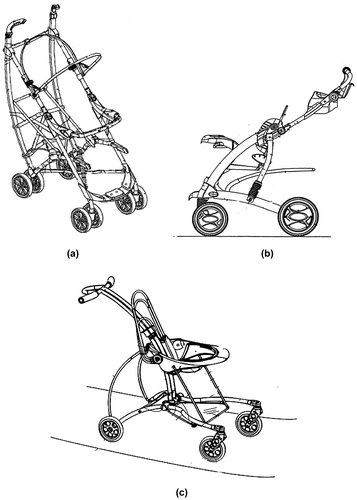
In Figure (b), Gregg R. Espenshade, Gregory S. Sellers, and Curtis M. Hartenstine designed a foldable baby stroller with a basket. The basket is located at the bottom of the frame where the frame connects the front and the back wheels. The stroller is collapsible downwards where the handle meets the frame of the rear wheels. The members that are locking the stroller in opened position slides along the rear wheel frame on one end, and pivots at the middle of the main upper frame (Espenshade, Sellers, & Hartenstine, Citation2007).
In Figure (c), Karen Jacy Madigan, Lynn Furton McIntyre, Daniel Lee Bizzell, Ian Douglas Kovacevich, and Kevin James Dahlquist designed a baby stroller. The stroller has a spine where the handle and the seat are attached. The seat has a plat surrounds it, and the backrest is adjustable. The base of the frame is flat where all four wheels are connected. The handle bar is placed on the top part of the curved spine (Madigan, Mcintyre, Bizzell, Kovacevich, & Dahlquist, Citation2007).
3.28. Year 2008
In Figure (a), Chin-I Lai designed a baby stroller that includes an upper support, a front wheel support, a rear wheel support, a curved rib, a connecting bar, a bracing bar, and a guard handle. The rear wheel support and the curved rib are the members that are responsible for the folding process. The wheels are designed to receive a braking system, and the whole braking system is controlled by wires that are mounted internally. The frame that holds the seat is able to rotate and locked into position (Lui, Citation2008).
Figure 30. Baby stroller designs in 2008 (Lan, Citation2008; Lui, Citation2008; Yeh et al., Citation2008).
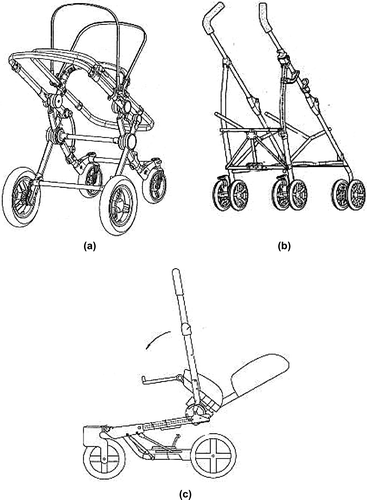
In Figure (b), Chuan-Ming Yeh, Youn-Fu You, and Wei-Yeh Li designed a single hand folding baby stroller. The stroller folds from side to side. The folding mechanism uses sets of linkages where all are activated with a single pull of the driver linkage. When the pusher pulls the driver linkage, other linkages will be pulled by the action. An elastic element of the frame assists the folding of the frame where the user can fold the frame of the stroller easily and effortlessly. This way the user can operate with a single hand, without using a foot, to release the frame to fold (Yeh, You, & Li, Citation2008).
In Figure (c), Red Lan designed a foldable baby stroller where the angle of the seat is adjustable. The angle of the handle is also adjustable and the pusher can choose to face forward or to face the baby. The design has three wheels, one in front and two behind. The front wheel is able to rotate in place (Lan, Citation2008).
3.29. Year 2009
In Figure (a), Ming-Tai Huang designed a three-wheel foldable baby stroller that uses a U-shaped main frame. The stroller is able to collapse down if the locking mechanism is disengaged. Each set of wheels has two wheels and all set of wheels are able to rotate in place (Huang, Citation2009).
Figure 31. Baby stroller designs in 2009 (Huang, Citation2009; Cheng, Citation2009; Yoshie & Ukitsu, Citation2009).
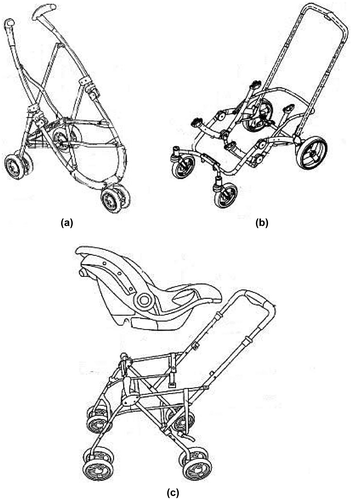
In Figure (b), Huang-Yi Cheng designed a baby stroller frame that has a four point mounting system. The mounting system forks upwards and each end of the fork is a lockable latch to receive and lock the seat in place. The forks can be folded where the two frontal forks meet the two rear forks. The stroller frame can also be folded where the front wheels meet the rear wheels. This folding action also contributes to the folding action of the forks (Cheng, Citation2009).
In Figure (c), Toshiro Yoshie, and Yutaka Ukitsu designed a baby stroller with a detachable seat. It uses a mounting mechanism where then carrying handle is turned and the seat locks into place. To unmount the seat from the base, simply pull the carrying handle into upright position (Yoshie & Ukitsu, Citation2009).
3.30. Year 2010
In Figure (a), Richard E. Cone II designed a foldable baby stroller that can be folded into a compact size. The members of the front wheels and the rear wheels are connected together and pivot about the mid frame. The rear wheels swivel towards the front wheels and the structure can be collapsed down. The handle also collapses and the stroller is in folded position (Cone, Citation2010).
Figure 32. Baby stroller designs in 2010 (Cone, Citation2010; Hou, Citation2010; Longenecker & Williams, Citation2010).
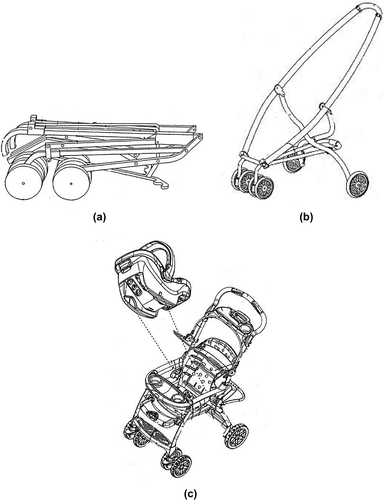
In Figure (b), Hung-Chung Hou designed a baby stroller frame with a simple oval shaped frame. The frame is held upwards with a scissor mechanism that links the lower frame with the oval frame. The lower frame connects the front wheels to the rear wheels. Disengaging the scissor mechanism will allow the stroller to collapse down. The structure of the stroller is simplified and the cost for manufacture will be less (Hou, Citation2010).
In Figure (c), Michael L. Longenecker and Bruce L. Williams designed a foldable baby stroller where the seat is detachable from the stroller frame. The angle of the seat is also adjustable whether it is in folded or opened position. The stroller can be folded with one hand. The handle of the stroller can be extended upwards (Longenecker & Williams, Citation2010).
3.31. Year 2011
In Figure (a), Shun-Min Chen and Zhi-Ren Zhong designed a collapsible baby stroller where the frames are stacked in parallel manner. The seat is fixed and has a small table for the baby located in front of the seat. The small table holds small things such as toys and plates. The stroller folds with the rear wheels fold towards the front wheels and the handle also folds towards the front wheels. The handle is designed to receive a cup holder (Chen & Zhong, Citation2011).
Figure 33. Baby stroller designs in 2011 (Chen & Zhong, Citation2011; Cone, Citation2011; Yeh, Citation2011).
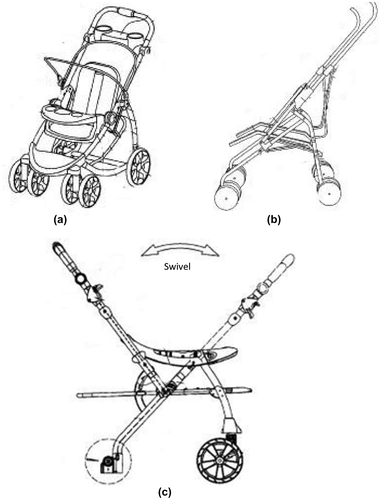
In Figure (b), Richard E. Cone II designed a light foldable baby stroller with a fixed seat and footrest. The stroller folds from side to side and the two handles meet. The front wheels are able to rotate in place and the rear wheels has fixed rotations. The stroller can further be folded with the rear wheel support swings towards the front wheels (Cone, Citation2011).
In Figure (c), Chuan-Ming Yeh designed a brake mechanism for a baby stroller. The handle is bidirectional where the pusher is able to choose to face the baby or to face forward. The actuator for the braking mechanism is on the handle where it slides along the handle and a series of wires are being pulled. The wires are then activating the braking mechanism. The braking mechanism works regardless of where the pusher is facing (Yeh, Citation2011).
3.32. Year 2012
In Figure (a), Ward Fritz, Andrew W. Marsden, Walter S. Bezaniuk, and Joe Langley designed a baby stroller that includes a mounting base and a baby seat mounted on the mounting base. The base of the baby stroller includes wheels and a foldable frame for carrying the baby seat (Fritz, Marsden, Bezaniuk, & Langley, Citation2012).
Figure 34. Baby stroller designs in 2012 (Fritz et al., Citation2012; Longenecker & Greger, Citation2012; Saville et al., Citation2012).
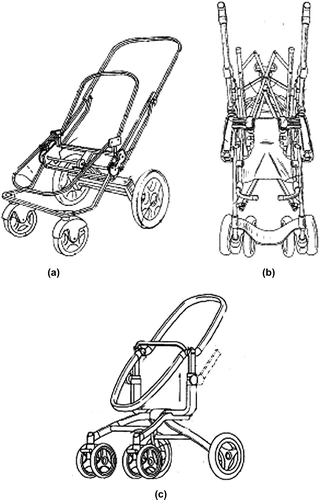
In Figure (b), Michael L. Longenecker and Jeff G. Greger designed a three-dimensional folding baby stroller featuring movable seat. The seat moves between a first position, where the seat is secured to the stroller, and a second position that facilitates folding. The stroller also features a adjustable backrest that is operable by one hand (Longenecker & Greger, Citation2012).
In Figure (c), Derek Saville, Daniel Newhard, Nico Michler, Christian Busse, and Bianca Fleischer designed a baby stroller where the height of the handle and the seat is adjustable. The height adjust can be engaged by unlocking the latch at the sides of the frame. The base of the frame supports four sets of wheels where the front wheels are able to turn about (Saville, Newhard, Michler, Busse, & Fleischer, Citation2012).
3.33. Year 2013
In Figure (a), Dao-Chang Li designed a baby stroller that is capable to be used with a car seat. The stroller seat can be set into an upright and can be placed on a car seat facing forward of the car. The stroller seat also can be set where it elongates and lays flat and can be placed on a car seat facing sideways of the car. The stroller seat includes a support frame that extends beyond and rise above the stroller seat (Li, Citation2013).
Figure 35. Baby stroller designs in 2013 (Chen & Li, Citation2013; Chen & Xiao, Citation2013; Li, Citation2013).
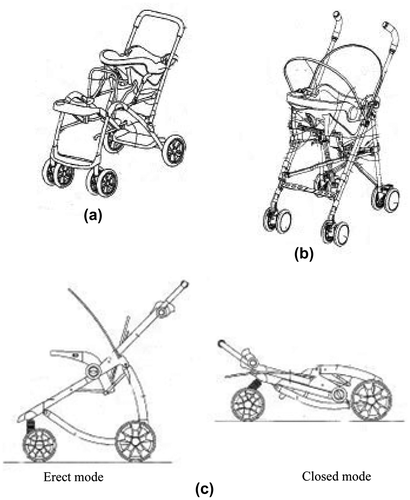
In Figure (b), Shun-Min Chen and Xiao-Hong Xiao designed a stroller that is designed to be used with a car seat. The footrest is removable and it is located in between the two structures on the sides. The locking device is located in between one of the side rod sections. The stroller includes an angle-limiting mechanism and an actuator to activate the angle-limiting mechanism so the footrest can be erected (Chen & Xiao, Citation2013).
In Figure (c), Shun-Min Chen and Jian-Qun Li designed a foldable baby stroller that is capable to be collapsed to a compact size. As such, the back frame side pivots towards the rear legs. The frame includes two knuckles located at the bottom ends of the back-frame side rod sections, with two latch mechanisms included. The latch mechanisms are able to lock the frame in an unfolded or folded position (Chen & Li, Citation2013).
3.34. Year 2014
In Figure (a), Rachelle Davis Hatfield and Nicole Tena designed lighting systems for baby strollers that enable users to integrate straight forward and modular lighting elements with eco-friendly practices to produce useful products whose functionality meets the safety levels and consistent with statutory schemes for other wheeled vehicles, assuring visibility to both pedestrians and other traffic users. The lights are place in front and at both sides of the stroller (Hatfield & Tena, Citation2014).
Figure 36. Baby stroller designs in 2014 (Adolfsson & Thalen, Citation2014; Conrad & Chen, Citation2014; Hatfield & Tena, Citation2014).
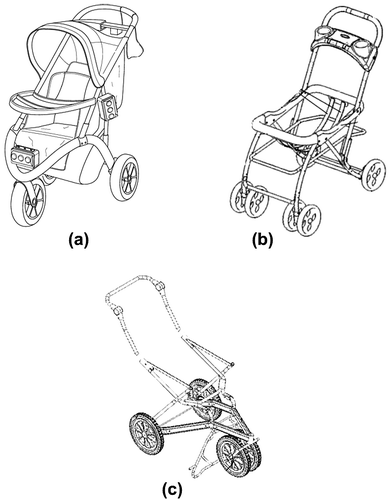
In Figure (b), Derek Conrad and Jung Tsai Chena designed a baby stroller that is also a car seat. The stroller has a frame structure that includes a seat mount and a push handle. The seat mount frame has four sides that form a rectangle. The seat is attached to the frame with a series of straps that surrounds the mounting frame. The support straps are easily adjustable lengthwise (Conrad & Chen, Citation2014).
In Figure (c), Johan Adolfsson and David Thalén designed a baby stroller with extra stands to support the stroller and allow the stroller to stand still. The stand can be engaged or disengaged with and actuator on the bottom of the frame. The stand protrudes down and lifts the baby stroller at a slight height (Adolfsson & Thalen, Citation2014).
4. Summary of designs in previous years
From the literature survey analysed from year 1980 to year 2014, a few important points can be highlighted on the design and development of baby strollers. They are as follow:
| • | Ergonomic design is implemented since 1980. | ||||
| • | Earlier designs focus more on just the ability to move and transport. | ||||
| • | Maneuverability is improved with rotating wheels. | ||||
| • | Foldability in the early years uses too many movable parts which is considered unreliable and often fails. | ||||
| • | Seats are detachable and can be used as car seat. | ||||
| • | Features that makes the infant comfortable such as shades or canopy are common and necessary. | ||||
| • | Seats are not ergonomic for the baby. | ||||
| • | Motorized strollers benefit the pusher but sacrificing foldability and convenience during storage. | ||||
| • | Electronics in strollers are not properly implemented since battery is attached to the frame. | ||||
| • | Electronic features in strollers are lack of variety. | ||||
5. Major findings from the designs of the previous years
In the year 1988, J. Camille Tucker and Klaus D. Weiswurm designed a stroller that is convertible into a car seat without the need for the seat to be detached (Tucker & Weiswurm, Citation1988). The inspiration from this is to use the readily available devices such as a car seatbelt.
In the year 2000, Joan Rura designed baby stroller with cooling mechanism that is mounted on top of the canopy (Rura, Citation2000). The inspiration from this design is to improve the comfort of the baby by adding devices such as fans.
In the year 2002, Simon Suh designed a device holder that is attached to the frame of the stroller (Suh, Citation2002). The inspiration taken from this design is to equip baby strollers with various devices.
In the year 2004, Wayne H. Hanson, Wade M. Wolf, and William B. Phelps designed a baby stroller and a stroller base suitable for use with handicapped children (Hanson, Citation2004). The inspiration taken from this design is the ability of the stroller to adapt various types of bodies.
In the year 2014, Rachelle Davis Hatfield and Nicole Tena designed a lighting system for baby strollers (Hatfield & Tena, Citation2014). The inspiration from this design is the ability of the stroller to be used in dark areas.
6. Proposed state of the art multi-purpose ergonomic baby stroller
As seen in the previous section, the existing baby stroller design is far from perfect. The functions in one stroller do not cater to the needs of everyone. However, there are some potential ways to improve the design of the existing baby stroller. Assuming the baby is 2 to 3 years old.
6.1. The seat
The seat is the most important part of this design project. It is the key to the baby’s comfort and also the ergonomic factor of the stroller for the baby. The seat is sculpted so that it follows the shape of the baby’s spine and provides lumbar support as seen on Figure . Five-point restraint system is chosen with a quick release buckle. Figure shows that the seat is perforated so the baby’s backside is able to “breathe” by allowing air to freely move in and out. This helps to cool down the baby’s skin that is in contact with the seat.
The notches at the sides of the seat serve as slots to place the attachment as shown in Figure . In Figure shows a dummy attachment to visualize the placement of the attachment. There are many different types of attachments. The essential ones are the fans and the headlight attachments. The fan attachment as seen on Figure consists of two battery powered fans to help cool down the baby on a hot day. The fans are well guarded and the openings are grilled so it will not injure the baby if the baby decided to reach out while the fans are spinning. The canopy as seen on Figure helps protect the baby from harsh sunlight and it is detachable. It can be expanded forward in order to use it. It also can be retracted back in and detaching the canopy is not necessary. Figure shows the headlight attachment is used to shine the way during night walks. It is battery operated and bright power-saving LEDs are used. Another attachment is the head guard where it is useful when the seat is used as a car seat, which will be explained in another section. Each attachment that requires power has its own battery pack. This allows attachments to be individually charged and help prevent the issues of having no more power for other attachments for different scenarios.
Babies get very uncomfortable if they are placed in a confined space like a baby stroller. To calm them down, parents would have to pick up their baby from the seat and try to get them to fall asleep. This issue can be solved by making the seat rockable. By attaching the seat onto the frame with bungee cords, the seat will be able to move up and down. This can be seen in Figure . The same concept used in a rockable baby crib, this motion will help the baby to fall asleep. The extrusions on the frame as seen on Figure helps to guide the seat while it is moving up and down, preventing it from rotating while doing so. Figure shows the seat is secured in place by engaging the latches that are attached to the seat. The latches hold onto the bases which are connected to the bungee cords.
6.2. The stroller frame
As seen in Figure and Figure , the seat is positioned high above the ground to prevent the baby from inhaling dusty air. The frame is a rectangle type frame with four sets articulating wheels, have 2 tires each. The frame is made of light and strong aluminum with certain plastic parts. The frame has rounded sides and it is hollow as seen on Figure . This will reduce the overall weight of the frame but still maintain its rigidity. The rounded sides will prevent large pressure acting on the pusher’s skin and also prevent potential injury to the baby. The low thermal conductivity ensures the comfort of the pusher if the stroller is left under the hot sun.
Figure 47. Frame cross-section (Sanders, Citation2001).

The pusher has the ability to choose on which the baby is facing. As seen if Figure , the baby is facing towards the front, away from the pusher. This is important because babies find it fascinating to scan their surroundings. The change the direction, the pusher must swivel the handle as seen on Figure . This way, the baby faces the pusher and the pusher is able to see the baby’s adorable face.
The height is high enough for the pusher to be comfortable and have his or her arms at a relaxed position with the hands at elbow level as shown in Figure . This position reduces fatigues during a long trip. A straight posture is maintained since the pusher does not have to lean forward in order to push the stroller. There is enough leg room in front of the pusher to comfortably move without his or her foot getting in contact with the stroller while walking. This way, the pusher does not need to extend his or her arms to gain more leg room.
There are times when the pusher needs to use multiple attachments on a trip. To change from one attachment to another made easy with the holder on the frame. Additional attachment can be stored at the back of the frame for easy access as shown in Figure .
Another feature of the frame is its foldability. The frame can be folded to save space, which is important for storage. User can fold the stroller to fit it into the back of the car or in the closet. It is also convenient for the pusher if the stroller needs to be carried around. From the open position in Figure , there is a significant reduction in size and space consumption when it is folded as shown in Figure .
Hooks are available on the frame as seen in Figure . By this, the stroller can be hanged for storage purposes. Users can do so while the stroller is in a folded position. For example, this allows user to hang the stroller on a shopping cart as seen on Figure . The presence of this hook increases the flexibility in storage options.
6.3. The handle
The handle is wrapped with a soft material as shown in Figure . The dense spongy material is capable of absorbing moisture and sweat and provides a good grip for the pusher. The large diameter of the grip reduces strain on the palm of the hands. The sides of the handle are rounded for the pusher to grip on. As seen on Figure , the hand is rotated slightly from the horizontal. The hand is at a neutral position and reduces strain on the forearm muscle.
6.4. The tyres
In Figure , the tyres are connected to a freely rotating member. This allows great maneuverability and provides good control for the pusher. Shock absorber makes bumpy ride to a smooth sailing and also reduces vibrations acting on the baby and the pusher’s hands.
6.5. The attachments
All attachments that require power has built in rechargeable batteries. Attachments are charged through a Universal Serial Bus (USB) port which is very common among electronics today. Attachments can be charged with any power supply that has the same connector. The attachment does not necessary to be on the stroller to be charged. These attachments are inspired by modular design where the pusher is able to “plug and play” the attachment that is needed. It is very easy to be removed and attached with no locking mechanism is required. Since the attachments are self- powered, there are no cables attached to the frame which minimizes the complexity of design and fabrication.
The headlight attachment is operated with rechargeable batteries and it faces the front of the baby stroller as seen on Figure . The low powered LEDs shine bright at a cost of a very little power consumption. These efficient LEDs allow the batteries to last longer on a single charge. At nighttime, pusher can illuminate the road in front. It is very useful while strolling in dark areas and knowing what is ahead gives a good sense of security. Figure shows that the headlight is adjustable by rotating it to the desired position, thus improving the reliability of the attachment.
Figure shows the fans attachment and it be inserted easily to attach it to the seat. The fans provide a cool breeze to the baby with the high airflow fans. It is operated at low revolutions per minute to keep the noise level of the fan down. To protect the baby, fan grills are installed so injuries can be avoided if the baby decided to reach forward and touch the spinning fans. The placement of the fan grills can be seen on Figure .
6.6. Stroller seat as a car seat
The advantage of the seat that is detachable from the stroller frame is the capability of the stroller seat to become a car seat. Most strollers have complex base mounting mechanism to secure the baby car seat into place. For the stroller seat to become a car seat, the head guard attachment must be used as shown in Figure . The attachment also doubles as a mounting mechanism to place the seat securely as a car seat. The head guard attachment is hard shelled and has soft cushions on the inside. The head guard attachment has seatbelt rings so seatbelt can be threaded into it.
To use the mounting mechanism, a typical car seatbelt can be used. Seatbelt is threaded into the seatbelt rings and buckled on the seatbelt buckle as shown in Figure . This requires no mounting base to secure the seat in place. Other than functioning as a mounting mechanism, the head guard attachment also prevents the baby’s head from over extending in case of frontal collision. The soft cushion absorbs the impact preventing upper extremity injuries (see Figure ).
6.7. The harness system
A five-point harness system has five straps connected to one buckle as shown on Figure . This provides safe and secure harnessing for the baby. Upper extremities activities are limited which may cause discomfort but safety is rest assured. The two straps on the upper part prevent the baby from crawling up and out of the stroller. The three straps on the lower part prevent the baby from sliding down the stroller.
With the right ideas in mind, the concept of modularity can further be expanded depending on the needs of the people in the future. Although the idea of implementing it into a baby stroller may have come from the long sessions of thinking during shower and daydreaming, the potential of it to serve the better future is high. With the high possibilities of implementing computers into the modular attachments, the era of smart baby strollers would emerge.
As battery technology has becoming more advanced, it could perhaps power the stroller itself. In the future, efficient and reliable powered baby strollers will be a reality. However, humanity may have gone too far if the idea of self-driven baby stroller emerges. Material is also a concern when it comes to producing baby strollers. Light and strong material like carbon fiber has the potential to replace the current aluminium and steel frames. This would further improve efficiency and comfort, and also can become one of the excuses to increase the costs of the already expensive baby strollers in the market.
On the opposite side, baby strollers can also be affordable with the usage of natural fibre composite material, which is recyclable and eco-friendly material. Hence, the stroller can be recycled into desired useful components once it has reached its life span. In summary, the future of baby strollers is bright as technology advances. For an instance, controlling, locating, managing baby strollers would be possible with just a few clicks using smart phones.
In the future, third part attachments could be available and can be bought separately. Customers can choose to have what they require for their baby strollers. By outsourcing the design and manufacturing of the attachments will allow this unique idea to grow larger into a greater product. The possibilities of various types of attachments will be endless.
Additional information
Funding
Notes on contributors
Umar Nirmal
Umar Nirmal works as a Senior Lecturer at the Faculty of Engineering and Technology, Multimedia University, Melaka Campus, Malaysia. His research interests are in the area of Ergonomics and Human Factors, Human and Machine Interface, Green Materials and Tribology. Currently, he and his research team are working intensively to fuse the usage of electronics devices with ergonomic baby strollers. These devices are state of the art “plug and play” attachments to the baby strollers such as headlights, cooling fan and warmers. To date, he has more than thirty international ISI and SCORPUS journal articles, six international conferences proceedings and two book chapters. He had received multiple international awards on his outstanding research works.
References
- Adolfsson, J., & Thalen, D. (2014). Baby carriage with stand to prevent tipping. US8646803.
- Aitken, W. (1996). Single wheel baby stroller. US5511802.
- Alldén, P. O. (1985). Collapsible stroller. US4506906.
- Amato, J. (2004). On foot: A history of walking. New York, NY: New York University Press.
- Anderson, D. (2001). Stroller having an upper body exercise propulsion mechanism. US6196947.
- Andrisin, J. J. (1995). Adjustable stroller reclining mechanism. US5393122.
- Andrus, M. A. (1999). Stroller. US5887889.
- Barenbrug, M. (2003). Buggy. US6513827.
- Besaw, G. L. (2006). Combined baby car seat and stroller. US6986518.
- Bigo, J. (1987). Light push chairs of the foldable type. US4640519.
- Bigo, J. (1991). Folding child’s push chair. US5074575.
- Bigo, J. (1995). Compact folding child’s stroller. US5388852.
- Bretschger, E. B., & Myers, P. J. (2005). Stroller. US6843498.
- Cabagnero, R. J. (1990). Foldable frames for children’s pushchairs. US4892327.
- Chaw, N., & Hwang, H.-D. (1993). Stroller for a baby. US5224720.
- Chen, E.-J., Hou, H., & Huang, Y.-Y. (1999). One-handed foldable stroller. US5938229.
- Chen, F. (1990). Folding cart. US4934728.
- Chen, F. (1992). Foldable stroller. US5123670.
- Chen, S. M. (1994). Dual-seat stroller. US5333893.
- Chen, S. M. (2007). Stroller frame foldable in two directions. US7178822.
- Chen, S. M., & Li, J.-Q. (2013). Foldable stroller. US8444170.
- Chen, S. M., & Xiao, X.-H. (2013). Stroller connectable with a car seat. US8414012.
- Chen, S. M., & Zhong, Z.-R. (2011). Collapsible stroller. US7871100.
- Cheng, H.-Y. (2009). Baby stroller frame. US7475900.
- Cone, R. (1986). Collapsible stroller. US4606550.
- Cone, R. (1992). Child’s combination carseat and stroller. US5104134.
- Cone, II, R. (2010). Flat fold stroller. US7641216.
- Cone, II, R. (2011). Folding stroller including locking mechanism. US7900952.
- Conrad, D., & Chen, J. T. (2014). Stroller with a receiving frame and support straps for receiving a car seat. US8646802.
- Davidson, W. (1999). Stroller including a motorized wheel assembly. US5937961.
- de la Fe, A. B. (1983). Folding stroller for transporting children. US4369986.
- Duvignacq, M.-C. (1983). Inclinable support, particularly for child’s carriage. US4398748.
- Eichhorn, A. E. (1997). Stroller. US5590896.
- Espenshade, G. R., Sellers, G. S., & Hartenstine, C. M. (2007). Stroller with drop-down basket. US7185909.
- Ettridge, J. (1981). Child’s stroller. US4294464.
- Fleischer, H. (1981). Collapsible frames for baby carriers. US4256325.
- Fritz, W., Marsden, A. W., Bezaniuk, W. S., & Langley, J. (2012). Compact collapsible stroller. US8087689.
- Garforth-Bles, T. (1993). Wheeled vehicle for carriage of children convertible between jogging and bicycle trailer configuration. US5176395.
- Garforth-Bles, T. (1994). Wheeled vehicle for carriage of children convertible between jogging and bicycle trailer configurations. US5344171.
- Garrett, M., McElroy, A. M., & Staines, A. (2002). Locomotor milestones and babywalkers: Cross sectional study. BMJ, 324, 1494.10.1136/bmj.324.7352.1494
- Gebhard, A. W. (1989). Combination infant stroller and baby bassinet. US4836573.
- Giordani, P. (1982). Adjustable-backrest collapsible stroller. US4353577.
- Glover, R., & Cone, R., & Turner, D. M. (2001). Stroller with removable seat. US6286844.
- Graziano, E., Graziano, D. (1997). Child carriage with detachable wheel-axle assemblies. US5593174.
- Guillaume, R. (1984). Support for child. US4438941.
- Guo, J.-T. (2005). Foldable baby stroller. US6843499.
- Hanson, W. H. (2004). Stroller and stroller base with height adjustment capability. US6715783.
- Harada, S., & Harada, K. (1986). Convertible stroller. US4586721.
- Hartenstine, C. M. (2000). Stroller having a brake assembly. US6022042.
- Hatfield, R. D., & Tena, N. (2014). Enhanced stroller lighting processes products thereby and accoutrements. US8622570.
- Hou, H. (2010). Baby stroller frame. US7651116.
- Hsia, B. M. (2002). Foldable stroller with detachable supplemental seat. US6378892.
- Hsia, B. M. (2003). Stroller with adjustable seat back arrangement. US6557871.
- Huang, L. C. (1996). Stroller with switchable handle. US5513864.
- Huang, L. C. (1998). Stroller with a Standing Means. US5725238.
- Huang, M. (2009). Foldable three-wheel stroller. US7568721.
- Hyde, R., & Carmichael, L. T. (1984). Foldable infant stroller. US4478427.
- Kassai, K. (1980). Baby carriage. US4191397.
- Kassai, K. (1986). Baby carriage. US4610460.
- Kassai, K. (1987). Baby carriage seat belt. US4650252.
- Kato, H., & Arai, Y. (1993). Folding stroller with detachable seat. US5201535.
- Kitayama, T. (1996). Baby carriage. US5490685.
- Knight, D. F. (2006). Adjustable, bi-directional, removable baby stroller handle. US7011335.
- Kolbus, B. D. (1997). Convertible trailer and jogging stroller for two children. US5599033.
- LaFreniere, T. R. (1989). Combination stroller and car seat. US4832354.
- Lan, R. (2000). Stroller with detachable auxiliary seat. US6045145.
- Lan, R. (2004). Foldable stroller. US6722690.
- Lan, R. (2008). Foldable stroller. US7441794.
- Leech, J. (1847). The docile husband. Retrieved October 22, 2015, from http://www.john-leech-archive.org.uk/1847/docile-husband.htm
- Li, D.-C. (2013). Stroller connectable with a car seat. US8398098.
- Lin, W. (2004). Foldable three-wheel baby carriage with a shock absorbing function. US6739616.
- Lockett, D., Hruby, J. T., & Roth, J. G. (1991). Convertible stroller and trailer combination. US5076599.
- Longenecker, M. L., & Greger, J. G. (2012). Three dimensional folding stroller with infant carrier attachment and one hand actuated seat recline. US8100429.
- Longenecker, M. L., & Williams, B. L. (2010). Foldable stroller with memory recline. US7686322.
- Lui, C.-I. (2008). Stroller. US7401803.
- Madigan, K. J., Mcintyre, F., Bizzell, D. L., Kovacevich, D., & Dahlquist, J. (2007). Standing baby stroller. US7234722.
- Mar, S. (1987). Babyler folding baby stroller for multiple uses. US4641844.
- March, J. (1992). Collapsible infant seat carrier. US5121940.
- Miyagi, T. (1985). Baby carriage. US4506907.
- Nakao, S., Ishii, Y., & Matsuda, H. (1985). Baby stroller. USD277745.
- Nakao, S., Kobayashi, K., & Moriya, K. (1980). Baby stroller. USD254969.
- Nakao, S., Suzuki, Y., & Kato, H. (1989). Foldable baby carriage. US4832361.
- O’Shen, T., & Ayre, W. (2003). Collapsible stroller. US6533310.
- Owens, V. (1992). Combination infant carrier, car, seat and stroller. US5133567.
- Perego, G. (1982a). Adjustable baby stroller handle rod. US4354689.
- Perego, G. (1982b). Baby carriage. USD262696.
- Perego, G. (1988). Folding baby carriage. US4741551.
- Rura, J. (2000). Baby carriage with cooling mechanisms. US6027137.
- Sadler, E. L. (1990). Infant conversion stroller. US4921261.
- Saint, N., & Pike, R. T. (1998). Stroller having a break-away basket. US5741021.
- Sanders, Jr, R. E. (2001). Technology innovation in aluminum products. JOM, 53, 21–25.10.1007/s11837-001-0115-7
- Saville, D., Newhard, D., Michler, N., Busse, C., & Fleischer, H. (2012). Stroller with foldable frame and adjustable handle. US8128119.
- Sedlack, M. (2006). Infant car seat and stroller system. US7040694.
- Shamie, L. (1985). Foldable baby carriage with security lock. US4529219.
- Shamie, L. (1988). Tandem stroller. US4725071.
- Smith, C. D. (1994). Collapsible stroller. US5299825.
- Suh, S. (2002). Stroller adjustable holder. US6386490.
- Surot, P. (1984). Reversible foldable push-chair for children. US4449732.
- Suzuki, Y. (2002). Stroller. US6375213.
- Takahashi, T., & Katou, H. (1990). Baby carriage also usable as shopping carrier. US4923208.
- Tucker, J. C., & Weiswurm, K. D. (1988). Combination automobile seat and stroller. US4762331.
- University of Cambridge. (2015). Ornament. Cambridge: Author.
- Voytko, C., & Boudreau, R. (1983). Stroller canopy structure. US4378946.
- Wall-Scheffler, C. M., Geiger, K., & Steudel-Numbers, K. (2007). Infant carrying: The role of increased locomotory costs in early tool development. American Journal of Physical Anthropology, 133, 841–846.10.1002/(ISSN)1096-8644
- Wang, C. (1991). Stroller. US5056805.
- Wang, F. (1995). Foldable stroller. US5417450.
- Wang, M. (1998). Foldable two-seater stroller. US5722682.
- Worth, R. K. (2001). Folding stroller. US6189914.
- Yanus, T. (1989). Combined infant car-seat and stroller. US4834403.
- Yeh, C.-M. (2011). Brake mechanism for a baby stroller. US7905509.
- Yeh, C.-M., You, Y.-F., & Li, W.-Y. (2008). Single hand folding structure for umbrella folding stroller. US7434827.
- Yoshie, T., Ukitsu, Y. (2009). Stroller. US7513512.
- Yoshie, T., Ukitsu, Y., & Ikuno, T. (2005). Stroller with a reclining mechanism. US6851700.


